Food and Beverage Services - Basics
Food and beverage services sector contributes a great deal to the profits in hospitality industry. With the increase in importance of business meetings, a range of personal and social events, a large number of customers visit catering establishments frequently. The food and beverage professionals tirelessly work to intensify customers’ experience through their service.
The F&B Services providing businesses deliver food and beverages to their customers at a particular location (on-premise) such as hotel, restaurant, or at the customer’s intended premises (off-premise).
F&B Services – Definition
Food and Beverage Services can be broadly defined as the process of preparing, presenting and serving of food and beverages to the customers.
F&B Services can be of the following two types −
- On Premise − Food is delivered where it is prepared. The customer visits the premise to avail the food service. The premises are kept well-equipped and well-finished to attract customers to avail F&B service.For example, restaurants, pubs, etc.
- Off Premise or Outdoor Catering − This kind of service includes partial cooking, preparation, and service at customer’s premises. It is provided away from the F&B Services provider’s base on the occasion of major events which call for a large number of customers.
Types of F&B Services Operations
There are two broad types of F&B Services operations −
- Commercial − In this case, F&B Services is the primary business. The most known commercial catering establishments are — hotels, all kinds of restaurants, lounges, cafeterias, pubs, clubs, and bars.
- Non-Commercial − Non-commercial operations are secondary businesses in alliance with the main business. These F&B services mainly cater to their consumers with limited choice of food and beverages. These establishments often run under contracts. For example, food and beverage services provided at hospitals, hostels, and prisons.
In this tutorial, we mainly consider commercial food and beverage service sector. Let us first understand some common forms of F&B service.
What is Catering?
Catering is the business of providing foods and beverage service to the people at a remote location. It is a part of food and beverage service sector. For example, arranging food services at a wedding location.
What is QSR?
These are the fast food outlets called Quick Service Restaurants where the food is prepared, purchased, and generally consumed quickly. They are run with convenience as a main factor. Branded outlets such as McDonalds and Nando’s are QSRs.
What is FSR?
They are fine dining, family, specialty, ethnic, or theme restaurants called Full Service Restaurants where the food and beverage menu is wide and the customer’s expectations are high. They are operated with customer satisfaction and experience as the key factors.
Food and Beverage Services - Cycle
Food and Beverage Services come only after preparing what is to be served. Most food and beverage service businesses operate in the following cycle −
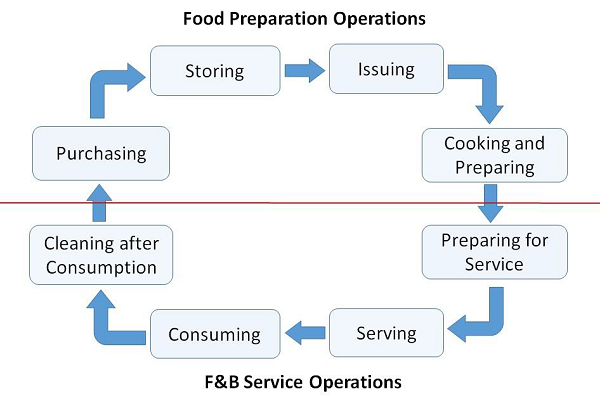
The upper half depicts food preparation related functions, whereas the lower half depicts food and beverage service to customers.
Food and Beverage Service Objectives
The food and beverage service is looked as a means of achieving satisfaction and making yourself feel comfortable in today’s world. The main objectives of this service are −
- To satisfy the following needs −
- Physiological − The need to taste different varieties of food.
- Economical − The need to get F&B Services at the invested cost.
- Social − The need to find friendly atmosphere.
- Psychological − The need to elevate self-esteem.
- To provide high quality food and beverages.
- To provide friendly and welcoming atmosphere.
- To provide professional, hygienic, and attentive service.
- To impart value for money.
- To retain the existing customers and to bring in new ones.
Food and Beverage Services - Terminology
The following terms are frequently used in F&B services −
| S. No. | Term & Meaning |
|---|---|
| 1 |
Back bar
A range of shelves displaying glassware and bottles.
|
| 2 |
Banquet
A sit-down meal served on the occasion of a formal or informal event such as a wedding party or a conference.
|
| 3 |
Binge Drinking
Drinking too much in a single session.
|
| 4 |
Buffet
A dining system where the guests serve themselves. Popular with a large number of guests and a small number of workforce.
|
| 5 |
Cocktail
Any mixed drink prepared using alcohol.
|
| 6 |
Condiments
Spices, sauce or other food preparations used to enhance the flavor or to complement the dish.
|
| 7 |
Crockery
Plates, dishes, cups, and other similar items, especially ones made of glass, earthenware, or china clay.
|
| 8 |
Cross-Contamination
It is a process of unintentional transfer microorganisms from one substance or object to another, with harmful effect.
|
| 9 |
Croutons
Crispy cubes of bread
|
| 10 |
Cutlery
Knives, forks, and spoons used for eating or serving food.
|
| 11 |
Deli
A store that sells pre-cooked fine food.
|
| 12 |
Dram Shop
American term for ‘Alcohol Bar’.
|
| 13 |
Gueridon Trolley
A trolley used in F&B Services business on which the food can be cooked, finished, or presented to the guest at the table.
|
| 14 |
High Ball (Long Drink)
Alcoholic beverage mixed with a large volume of soft drink and served in a tall glass with straw.
|
| 15 |
Mocktail
A non-alcoholic drink prepared using fruit juices or other soft drinks.
|
| 16 |
Pathogen
It is a biological agent that causes disease to its host.
|
| 17 |
Platter
A large flat dish or plate for serving food.
|
| 18 |
Pub
British name for ‘Public House’, an establishment licensed to serve alcoholic drinks.
|
| 19 |
Shot Ball (Short Drink)
Alcoholic drink consumed in a gulp. It is served in shot glass.
|
| 20 |
Situ
On site, locally.
|
| 21 |
Spot Checking
Regular surprise checking conducted to review standardized recipes and food products to maintain quality.
|
| 22 |
Station
A set of tables allocated to waiters in the F&B Services establishment.
|
| 23 |
Table Cover
It is the area on the table for plates, glasses, and cutlery for single person.
|
| 24 |
Tines
Parallel or branching spikes of a fork.
|
| 25 |
Toque
Cooks cap with multiple folds represents the many different ways a chef knows to prepare a dish.
|
Food and Beverage Services - Organization
The food and beverage service is part of the service-oriented hospitality sector. It can be a part of a large hotel or tourism business and it can also be run as an independent business. The members of the F&B Services team are required to perform a wide range of tasks which include preparation for service, greeting the guests, taking their orders, settling the bills, and performing various other tasks after the guests leave.
Let us see the F&B services in hotels, structure of F&B department and ancillary services in a hotel.
Food and Beverage Services in Hotel
Most of the star-ranked hotels offer multiple F&B services in their hotels. They can be −
- Restaurant
- Lounge
- Coffee Shop
- Room Service
- Poolside Barbecue/Grill Service
- Banquet Service
- Bar
- Outside Catering Service
Structure of F&B Services Department
The F&B Services personnel are responsible to create the exact experience the guests wish for. The department consists of the following positions −
Food & Beverage Service Manager
The Food & Beverage Service Manager is responsible for −
- Ensuring profit margins are achieved in each financial period from each department of F&B service.
- Planning menus for various service areas in liaison with kitchen.
- Purchasing material and equipment for F&B Services department.
Assistant Food & Beverage Service Manager
The Assistant Food & Beverage Service Manager is aware of and is tuned to all the work the F&B Services Manager performs and carries out the same in the absence of his superior.
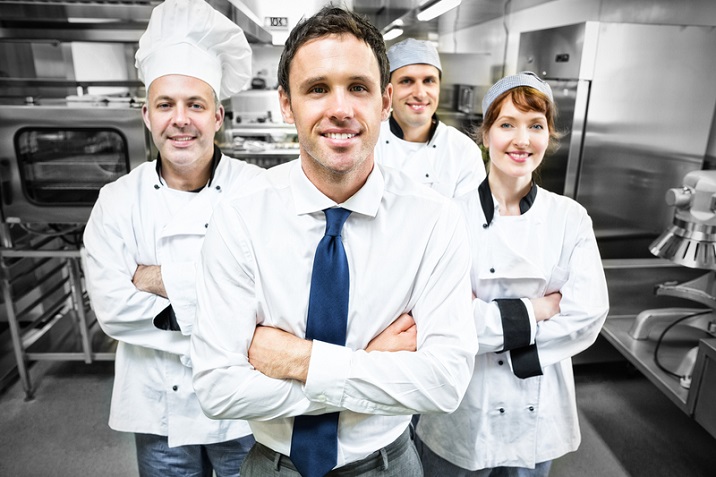
Restaurant Manager
The Restaurant Manager looks after the overall functioning of a restaurant. The responsibility of this staff member include −
- Managing the functions in the dining room
- Ordering material
- Stock-taking or inventory checking.
- Supervising, training, grooming, and evaluating the subordinates
- Preparing reports of staff and sales
- Managing budgets
- Handling daily sales and coordinating with cashiers
Room Service Manager
The Room Service Manager is responsible for −
- Selecting, training, encouraging, and evaluating all junior employees
- Ensuring that cultural values and core standards of F&B department/establishment are met
- Controlling labor expenses through staffing, budgeting, and scheduling
- Handling guest complaints
- Providing special requests
Banquet Manager
The Banquet Manager is responsible for −
- Setting service standard for banquets
- Forecasting and allocating budgets for various types of events such as conferences, meetings, etc.
- Achieving food and beverage sales
- Controlling chinaware, cutlery, glassware, linen, and equipment
- Handling decorations and guest complaints
- Providing special requests
- Purchasing required stock by following appropriate requisition procedures
- Following up each function by receiving guest feedback and submitting it to F&B Manager
- Participating in departmental meetings
- Planning and pricing menu
- Training, grooming, and development of staff underneath
Bar Manager
The Bar Manager is responsible for −
- Forecasting the daily flow of customers
- Allocating right number of staff according to customer influx
- Managing and monitoring bar inventory from store to bar
- Tracking all types of drink sales
- Allocating cleaning and tendering tasks
Food Safety Supervisor (FSS)
A Food Safety Supervisor is a person who is trained to recognize and prevent risks associated with food handling in an F&B Services business. He holds an FSS certificate that needs to be no more than five years old. He is required in an F&B Services business so that he can train and supervise other staff about safe practices of handling food.
F&B Ancillary Departments
Food and Beverage department relies upon the support of the following departments −
Kitchen Stewarding
The Kitchen Stewarding department strives to ensure cleanliness, preparedness, and orderliness in the commercial kitchen so that the kitchen staff can work efficiently. It also ensures that all the tools and utensils required for a specific meal or cooking task are cleaned properly and are ready to go. The kitchen steward is a working link between the F&B Services and the commercial kitchen.
Dishwashing
The Dishwashing department is responsible for providing clean and dry supply of glassware, chinaware, and cutlery for bar, banquet, lounge, and restaurant service.
Laundry
The F&B department is highly reliable on laundry department or outsourced laundry services for timely supply of dry-cleaned and wrinkleless linen.
F&B Staff Attitudes and Competencies
Each member of the F&B department hierarchy needs to have the following traits and skills −
Knowledge
Awareness of one’s responsibilities and roles, appropriate knowledge of food items, food and beverage pairing, etiquettes, and service styles is a great way to build confidence while serving the guests.
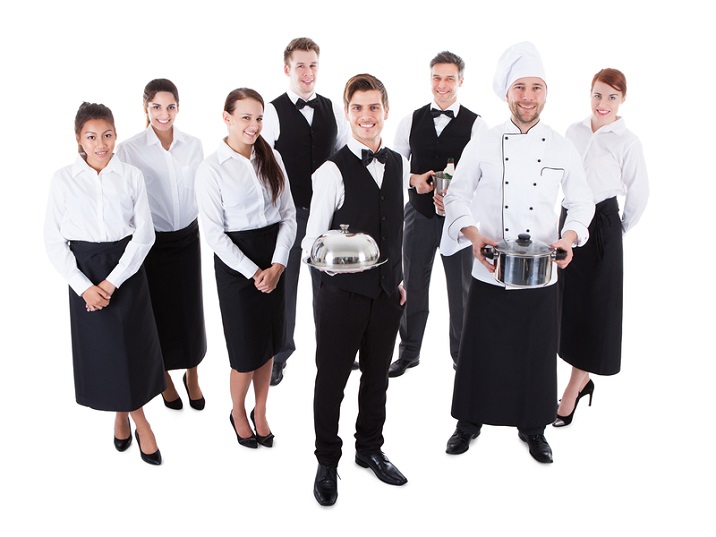
Appearance
It creates the first impression on the guests. The F&B staff members must maintain personal hygiene, cleanliness, and professional appearance while being on duty.
Attentiveness
Attentiveness is paying sincere attention to details, memorizing the guests’ needs and fulfilling them timely with as much perfection as one can put in.
Body Language
The F&B Services staff needs to conduct themselves with very positive, energetic, and friendly gestures.
Effective Communication
It is very vital when it comes to talking with co-workers and guests. Clear and correct manner of communication using right language and tone can make the service workflow smooth. It can bring truly enhanced experience to the guests.
Punctuality
The F&B Services staff needs to know the value of time while serving the guests. Sincere time-keeping and sense of urgency helps to keep the service workflow smooth.
Honesty and Integrity
These two core values in any well-brought-up person are important for serving the guests in hospitality sector.
F & B Services - Types Of Service
There are a number of service styles to be followed when it comes to how food and beverage should be served to the customers. The following are the most prominent styles −
Table Service
In this type of service, the guests enter the dining area and take seats. The waiter offers them water and menu card. The guests then place their order to the waiter. The table is covered in this service. It is grouped into the following types.
English or Family Service
Here, the host contributes actively in the service. The waiter brings food on platters, shows to the host for approval, and then places the platters on the tables. The host either makes food portions and serves the guests or allows the waiter to serve. To replenish the guests’ plates, the waiter takes the platters around to serve or to let the guests help themselves. This is a common family service in specialty restaurants where customers spend more time on premise.
American or Plate Service
The food is served on guest's plate in the kitchen itself in predetermined portion. The accompaniments served with the food, the color, and the presentation are determined in the kitchen. The food plates are then brought to the guest. This service is commonly used in a coffee shop where service is required to be fast.
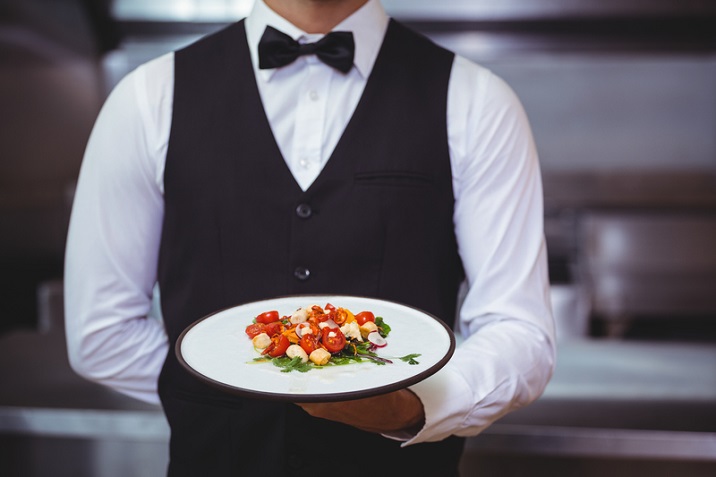
French Service
It is very personalized and private service. The food is taken in platters and casseroles and kept on the table of guests near their plates. The guests then help themselves. It is expensive and elaborate service commonly used in fine dining restaurants. This service has two variants −
- Cart French Service − The food is prepared and assembled at tableside. The guests select food from the cart while sitting at their tables and are later served from the right. It is offered for small groups of VIPs.
- Banquet French Service − The food is prepared in the kitchen. The servers serve food on each individual’s plate from guest’s left side. For replenishment, the servers keep the food platters in front of the guests.
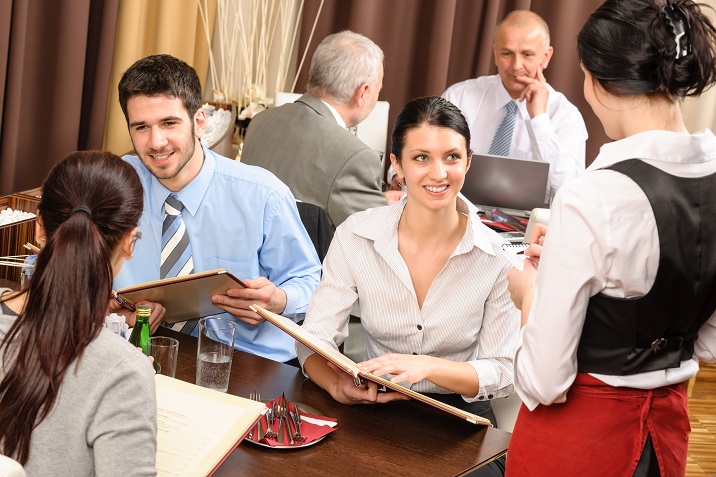
Gueridon Service
In this service, partially cooked food from the kitchen is taken to the Gueridon Trolly for cooking it completely. This partial cooking is done beside the guest table for achieving a particular appearance and aroma of food, and for exhibiting showmanship. It also offers a complete view of food. The waiter needs to perform the role of cook partially and needs to be dexterous.
Silver Service
In this service, the food is presented on silver platters and casseroles. The table is set with sterling silverware. The food is portioned into silver platters in the kitchen itself. The platters are placed on the sideboard with burners or hot plates. At the time of serving, the waiter picks the platter from hot plate and presents it to the host for approval and serves each guest using a service spoon and fork.
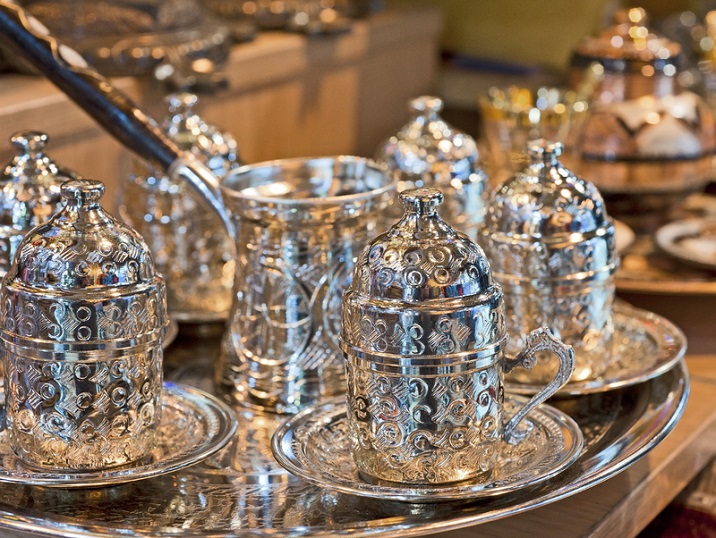
Russian Service
It is identical to the Cart French service barring the servers place the food on the platters and serve it from the left side.
Assisted Service
Here, the guests enter the dining area, collect their plates, and go to buffet counters and help themselves. The guests may partially get service at the table or replenish their own plates themselves.
Buffet Service
It this type of service, the guests get plates from the stack and goes to buffet counter where food is kept in large casseroles and platters with burners. The guests can serve themselves or can request the server behind the buffet table to serve. In sit-down buffet restaurants, the tables are arranged with crockery and cutlery where guests can sit and eat, and then replenish their plates.
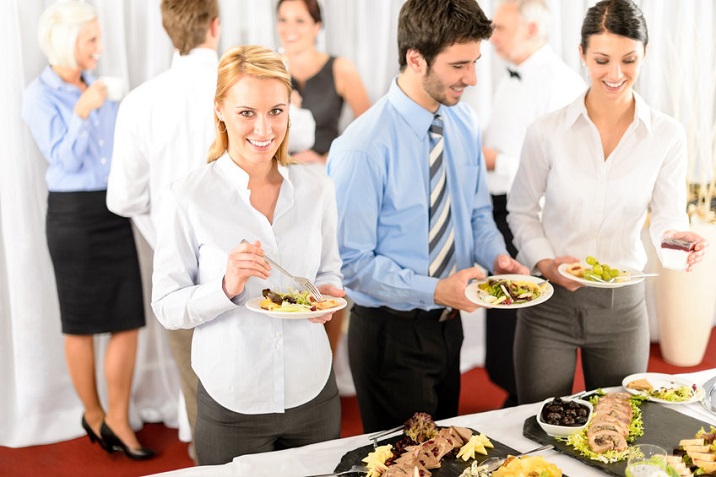
Self Service
In this type of service, the guests enter the dining area and select food items. They pay for coupons of respective food items. They go to food counter and give the coupons to avail the chosen food. The guests are required to take their own plates to the table and eat.
Cafeteria Service
This service exists in industrial canteens, hostels, and cafeterias. The menu and the space is limited; the cutlery is handed over to the guests. The tables are not covered. Sometimes high chairs are provided to eat food at narrow tables. It is a quick service.
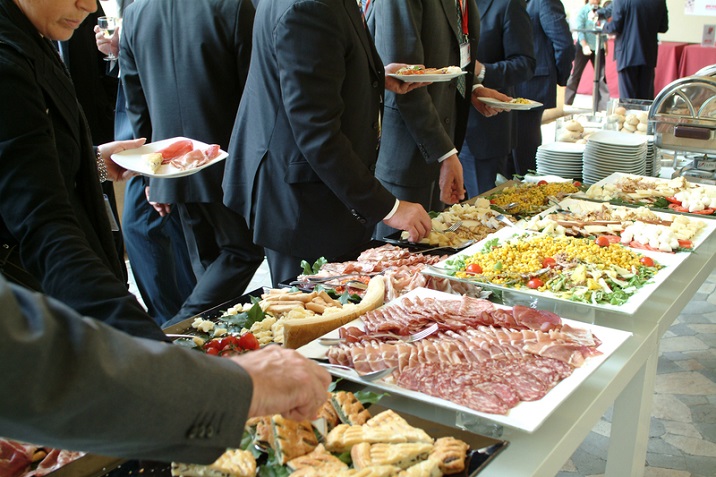
Single Point Service
In this type of service, the guest orders, pays for his order and gets served all at a single point. There may be may not be any dining area or seats. The following are the different methods of Single Point Service.
Food Court
This is an array of autonomous counters at which the customers can order, eat, or buy from a number of different counters and eat in adjacent eating area.
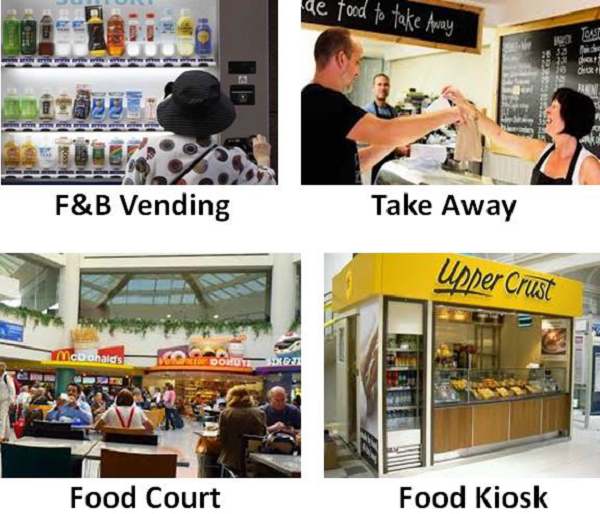
Kiosks
The customer enters the choice and amount of money physically and the machine dispenses what customer demanded accurately.
Take Away
Customer orders and avails food and beverage from a single counter and consumes it off the premises.
Vending
The customer can get food or beverage service by means of automatic machines. The vending machines are installed in industrial canteens, shopping centers, and airports.
Special Service
It is called special service because it provides food and beverage at the places which are not meant for food & beverage service. The following are the different methods of special service.
Grill Room Service
In this type of service, various vegetables and meats are displayed for better view and choice. The counter is decorated with great aesthetics, and the guest can select meat or vegetable of choice. The guest then takes a seat and is served cooked food with accompaniments.
Tray Service
Method of service of whole or part of meal on tray to customer in situ, such as hospitals, aircraft, or railway catering.
Trolley/Gueridon Service
Food is cooked, finished or presented to the guest at a table, from a moveable trolley. For example, food served on trollies for office workers or in aircrafts and trains.
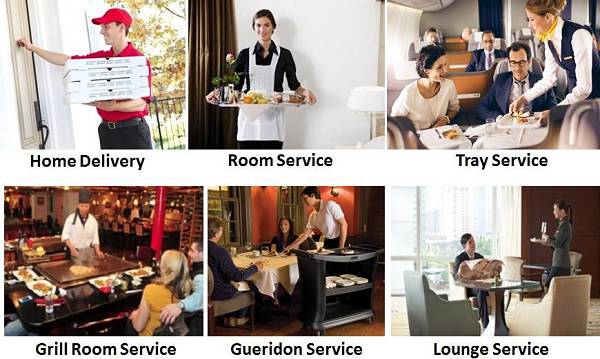
Home Delivery
Food delivered to a customer’s home or place of work. For example, home delivery of pizza or Meals on Wheels.
Lounge Service
Service of variety of foods and beverages in lounge area of a hotel or independent place.
Room Service
Here food is served to guests in their allotted rooms in hotels. Small orders are served in trays. Major meals are taken to the room on trolleys. The guest places his order with the room service order taker.
The waiter receives the order and transmits the same to the kitchen. Meanwhile, he prepares his tray or trolley. He then goes to the cashier to prepare and take the bill. He then takes the bill along with the food order for the guests’ signature or payment. Usually clearance of soiled dishes from the room is done after half an hour or an hour. However, the guest can telephone Room Service for the clearance as and when he has finished with the meal.
Food and Beverage Services - Outlets
Today, numerous types of food and beverage service outlets have come up in the market. They offer a wide range of food and beverage services that the customers can avail. The extent of service depends upon the type of service outlet. They include drive-through service of fast food where the customers can purchase their favorite food without having to leave their cars and pick-up points where food is delivered in minutes. There are also some elite class fine dining outlets which exhibit classy articles in the house and provide elaborate food services.
Here are some famous types of food and beverage outlets −
| Outlet | Menu | Ambience | Service |
|---|---|---|---|
| Airport Lounges | Wide menu for breakfast, lunch, and dinner with hot and cold beverages, salads, main meals, and desserts. | Soft instrumental music, soft lights, formal ambience, all appealing for having meals at leisure and resting gracefully at the airport | Self or Assisted service provided 24X7, round the clock. The traveler selects food and beverage of choice, and takes to the table himself. |
| Bars | Wide menu of soft drinks, alcoholic beverages, and light snacks. | Informal, relaxed atmosphere, energetic music, colorful flashy lights. | Push-low seating, speedy service of cocktails, mocktails, and snacks. |
| Cafeterias | Short dining menu with less food options. Follows cyclic meal plan. | Attached to educational institutes or industrial organizations | Self or assisted, pre-plated, low priced service. |
| Coffee Shops | Short menu with hot and cold beverages, snacks, and light meals. | Informal ambience with light music and moderate lighting. | Quick and mid-priced service for high customer turnover. |
| Discotheque/Nightclubs | Menu with snacks and beverages. | Strobe lights, laser lights, dance floor, lively music, informal and energetic atmosphere. | Entry permission for couples or members on charge, assisted service. |
| Family/ Casual Dining Restaurants | Elaborate menu of single or multiple cuisines which may change according to the operating hours. | Modestly furnished, Casual atmosphere. | Assisted, mid-priced service. |
| Fast Food Outlets | Limited menu of hot and Cold beverages with easily prepared and fast meals cooked in advance and kept warm. | Catchy trendy colored furniture, lights, and music. | Speedy service, minimum table service. The food is prepared in the kitchen, placed in the trays, and passed to the person at the counter, who then delivers to the customer. The customer picks up the trays and consumes it on premise. |
| Food Courts | Multi cuisine menu. | Multi-cuisine food outlets are located around modestly kept central dining area. | Speedy service with minimum personal attention. The customers pick up food and beverages of their choice from multiple outlets around and sit in the central dining area to consume. |
| Grill Rooms | Grilled meat or sea food with alcoholic/non-alcoholic beverages. | Attached to star hotels, gardens, or independent, may have open kitchen. Eye-catching counters. | According to hotel policies. |
| Poolside Barbeque | Roasted meats, crunchy vegetables, and seafood with wines and beer. | Located near swimming pools, Informal, relaxed atmosphere, energetic music. | Self/assisted service. |
| Pubs | Mostly alcoholic menu with snacks. | Informal and social ambience with less lighting and more chatting. | Push-low seating, self, or assisted service. |
| Specialty/Ethnic Restaurants | Specific menus such as Chinese, Italian, Indian, Thai, or Mexican. | Follows specific theme. Interior Decoration is in line with the theme. | Uniform of the service staff, linen, and service ware are according to the theme and from the country where the food originates. |
| Take-away Counters | Limited or elaborate menu of food and beverages. | Frontend counter for selling is attached to the pantry. | Pickup service where customer places order, waits till it is completed, and picks the food and beverages to consume them off-premise. |
| Themed Restaurant | Limited menu that is based on the theme. | Architecture, lighting, and music induce the feel of the theme. Mostly informal ambience. | American/Assisted service. |
| Vending Machines | Pre-packaged chips, portioned foods, canned beverages. | Located in high labor cost and limited space areas such as transport hubs. | Complete self-service. |
General Layout of F&B Outlets
Appropriate architecture of F&B outlet makes it prepare, present, and serve in optimum way and increase productivity. These are few basic considerations for various sections of F&B outlets −
Kitchen
It is farthest from the customers.
Store
It has large fridges, cupboards with multiple shelves, and lockers. It is attached to the kitchen.
Pantry
It is being the area where food or beverage is prepared ready to serve, it is located between the dining area and the kitchen.
Restrooms
There are two different schools of thought for location of restrooms − some experts consider that the restrooms must be near the entrance and some think that it should be isolated from entrance or dining area.
General Considerations for F&B Services Layout
While designing an F&B outlet, one needs to consider every factor that contributes to the smooth running of operations right from food preparation, cooking, dish presentation, serving, and all allied tasks.
While designing commercial F&B outlets, the following points are important −
- Target customer segment (Youth/Men/Women/All).
- Type of food (Light Food/Fast Food/Fine Dining).
- Manner of food production (Cooking/Grilling/Boiling/Baking/Steaming).
- Type of food distribution (On/Off Premise).
- Availability of carpet area.
- Number of staff required.
The kitchen is designed not to be directly visible. The chef cannot directly communicate to the guests. The guest tables and chairs are placed away from kitchen.
Food and Beverage Services - Operations
Food and Beverage Service operations involve a multitude of activities which engage the staff right from purchasing raw material, preparing food and beverage, keeping the inventory of material, maintaining service quality continuously, managing various catered events, and most importantly, analyzing the business outcomes to decide future policies.
Let us look into the operations involved in F&B service −
Product Cycle in F&B Service
The purchasing department in F&B Services is responsible for purchasing, storing, and issuing the supply of raw food items, canned/bottled beverages, and equipment. The following is a typical product purchasing cycle −
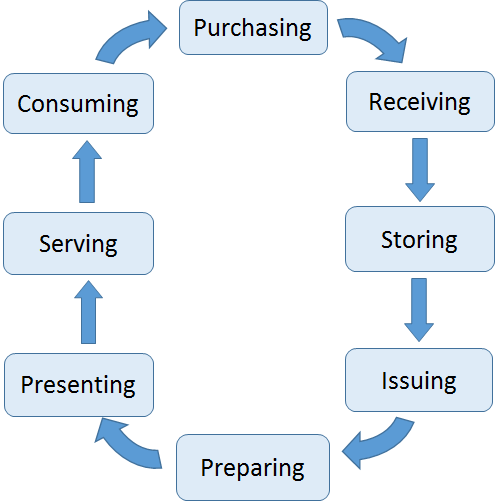
The purchasing department works with accounts department to keep the information on allocated budget and balance budget.
The following factors influence purchasing −
- Size of F&B Organization
- Location of F&B Organization
- Availability and Size of Storage Space
- Organization Budget and Policies
- Availability of the commodity due to season
Purchasing Product
The purchaser is responsible for purchasing a product. He studies the market, and analyzes and selects suppliers, wholesalers, and the contemporary market prices. He then liaisons with suppliers and wholesalers to get good material at fair price and purchases the required commodities by following appropriate purchase procedures.
Receiving the Product
The receiver receives the products from the suppliers. He checks the product for right quality and quantity. He deals with the delivery personnel from the supplier’s end and signs on the related receipts.
Storing and Issuing the Product
The store men carry out the task of storing received supply and issuing it to respective departments. They update the stock database, and manage old and new material in the stock. They also keep record of stock to the latest date.
Preparing and Presenting an F&B Product
This includes preparation of various food items and fresh beverages. The cooks prepare various foods and the bar tenders prepare cold beverages such as mocktails and cocktails. They also make the dish most presentable by arranging food on platter and decorating it in an attractive manner. The beverages are also decorated by using fruit slices, decorating the glasses, sippers, and stirrers.
Consuming the F&B Product
This part is played by the guests. At the service end, the respective staff takes inventory of the consumed and balanced stock of food and beverages and keeps it updated to latest figures.
Maintaining Food and Beverage Standards
It is very vital for an F&B Services organization or an F&B department in a large hotel to keep their standards of food and beverage high. If the quality of food and beverage along with the best service is what the guests liked, then the chances of the guests coming repeatedly and singing praises of what they received are high.
Food and Beverage Standards
Any food and beverage service business has a great responsibility of serving hygienic, safe, clean, and fresh food. The customers also rightfully question if the food or beverage they consume at the F&B Services outlet is healthy, safe, and fresh.
For ensuring food safety, a system named Hazard Analysis and Critical Control Points (HACCP) in Europe works to identify Critical Control Points (CCP) for the presence of physical, chemical, and bacterial hazards to food. HACCP has set guidelines and principles on producing healthy and safe food. It also enables food and beverage businesses to adhere to consistent safety and quality of food production.
In India, Food Safety and Standards Authority (FSSA) works towards setting standards for safe and hygienic food. In USA, Food Safety and Inspection Service (FSIS) is responsible for the safety of meat, poultry, and processed egg products. Also, the Food and Drug Administration (FDA) is responsible for virtually all other foods.
Managing Buffets, Banquets, and Catered Events
Before planning and executing buffets, banquets, or catered events, the respective managers and supervisors need to consider the following factors −
Type of Event
It can be formal such as seminars, meetings, or conference, or informal such as a wedding reception, birthday party, employee outing, and alike.
Involvement of Various Persons
The participants such as decorating staff, planning staff such as managers, serving staff, supervising staff, whole sellers, and the guests.
Event Requirements
It is important to know the date and time of event, the number of expected guests, dance floor, audio or projector systems, or any special requirement demanded by the guests before planning the event.
Decors
It includes flowers, table arrangement, center-pieces, candles, artificial fountains/waterfalls, decorative art pieces, plants and pots; for both formal and informal occasions with the involvement of décor artists. The display pieces may be carved, baked, or assembled; made of edible or non-edible substances according to the laid standards. The decoration needs to go in pair with the theme of the banquet, buffet, or some event.
Menu
According to the time of event, it can include starters, salads, breads, main courses (meats, poultry, or sea food), desserts (fruits, pastries, or frozen desserts), beverages, accompaniments, and garnishes according to the establishment standards. It must be hygienic, in-line with the occasion, and meeting the F&B Services establishment standards.
Serving Equipment
Depending upon the requirement of guests and serving style, it can include silverware, platters, table linens, and other required serving equipment. It also includes size and shape of tables and chairs.
Serving Norms
According to establishment norms, serving right food at right temperature, replenishing food platters timely, keeping the overall display neat and attractive, storing food and managing beverage consumption after service, cleaning buffet or banquet area, restoring plates, cutlery, Guerion trollies, and glassware after completion of service.
F & B Services - Analysis & Decision Making
The decision making responsibility in an F&B establishment rests with the managers. They have full access to the numbers, data, reports, and trends of the market as well as knowledge of F&B establishments.
F&B Services Analysis
The F&B services managers need to conduct financial analysis and quality analysis.
Financial Analysis is carried out in three steps −
Setting expectations (BUDGET)
The managers study current and future market trends and forecast expenses. Budgets are prepared based on managers’ inputs.
Evaluating actual situation (INCOME STATEMENT)
The managers also keep a keen eye on present situation in which F&B Services is functioning. They need to consider fixed costs such as rents and property taxes, and variable costs such as material, advertisement, and music and entertainment costs.
Analyzing the difference (PROFIT/LOSS)
They come up with the difference and find out the reasons and apply the required policies.
The Quality Analysis needs to consider the following factors while providing the food product or service. Some of these factors are −
- Evaluating ongoing product analysis checklist that includes doneness, aroma and taste of the ready dish, garnish, color, appearance, presentation, serving portion, and alike.
- Evaluating the food or beverage product for safety against consumption.
- Evaluating weekly review of product deviation that includes date, product name, problem, solutions, and recommendation.
F&B Services Decision Making
It includes coming up with corrective actions in case of certain unpleasant results. The managers make decisions after going through the following steps −
- Identifying problems
- Identifying reason
- Determining a number of solutions
- Selecting a best solution
- Applying the solution
- Evaluating the solution
For example, the response for chilled cucumber soup is declining for the past four months.
- Identify problems − Menu problem? Taste issue? Price issue? Serving quantity or quality issue?
- Identify reason − Soup is outstanding on quality, portion of service, and taste marks. But it is Winter and guests are preferring hot soups than the chilled ones though it is on the lunch menu.
- Solutions − Can a hot variant of the same soup be developed? Can the soup be replaced by a preferred alternative?
- Best solution − Shift chilled cucumber soup to summer-time menus and bring in a new hot soup or a variant of one of the present soups that will potentially rule the guests’ taste buds.
F & B Services - Menu Preparation
Food and beverages form an integral part of the human culture. Ever since human culture started evolving, food and beverages preparation also went on finding new ways. Today, every country flaunts a different line of food and beverages prepared in authentic culinary ways.
Over the past several years, various food and beverages have been developed using local crops, meats, fruits, and vegetables, and trying different recipes with them. This manner of development contributed in the authenticity of the food and beverages to a great extent.
What is Menu?
It is a detailed list of food and beverage offerings with their respective prices. It is prepared by a food and beverage service businesses to keep the customers informed about the availability of various F&B items.
A good menu must −
- Present clear, unambiguous information.
- Adhere to food safety and nutrition policies of the business.
- Meet or outstrip guests’ expectations.
- Meet the quality standards of the business.
- Be truthful in describing the taste and preparations.
- Be strictly going with the production and service facilities of the business.
Restaurant Menu Preparation
The restaurant menu should be planned well by considering various aspects of the food outlet. There are myriad menus available right from breakfast, lunch, small bites, up to dinner. The following information is gathered before planning food and beverage menu for a commercial kitchen.
- What kind of food outlet is it? (Vintage, Contemporary, Modern, Theme, Bar, and more)
- What is the name of the outlet?
- What is the expanse of food items, their accompaniments, and beverages the owner wishes to keep?
- Which information needs elaboration for food and beverages?
- What tone of language is required? (formal/informal)
- What types of names and category headings would best suit for the food and beverage items?
- What design, images, colors, and typeface would look best for the menu?
- Are the graphic details relevant to the food outlet theme?
- How large should the menu be on paper?
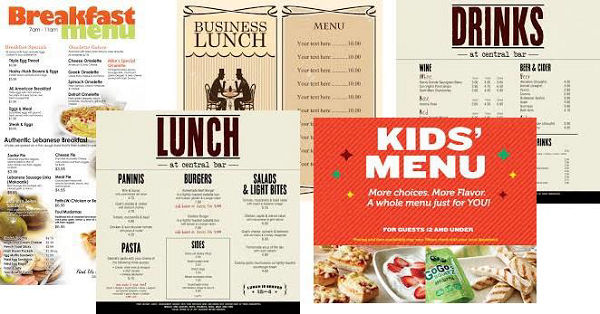
These days, numerous apps such as MenuPro, FineDine, MenuExpress, InnMenu, and more are readily available to create catchy and engaging menus. A good menu design is a treat for eyes that drive the guests to place orders.
Depending upon the expanse of physical outlet and service, and the variety of food and beverages it offers, the menu design and details change.
Menu Planning
This is the selection of menu in advance for an upcoming event. Menu planning plays an important role in customer satisfaction.
Menu planning is beneficial in the following areas −
- Purchasing of essential material in advance.
- Pricing of the food.
- Guiding the food preparation.
- Evaluating the dietary needs.
- Evaluating the food in terms of necessary improvements.
The menu must be planned such that it goes well with the theme of the F&B outlet and it must be a good bargain for food price and dietary value.
F & B Services - Ethnic Food Menus
There are various cuisines around the world. Each cuisine involves a lot of preparation. The following most famous ethnic menus are prepared in various cuisines around the world
Indian Food Menu
Indian food is perhaps as diverse as its culture and offers a lot more than curries and gravies. It balances all tastes — savory, sweet, salty, and sour. Indian food broadly goes according to the regions where it originates such as Northern, Southern, Western, and Eastern. Within regions it is varied according to states such as Kashmiri, Punjabi, Gujarati, Marathi, Keralite, Bengali, and so on. It is an authentic combination of the base food paired with aromatic herbs nuts, and spices.
It includes various appetizers, snacks and their accompaniments, veg and non-veg stews, various types of flat breads, plain or spicy lentils, rice preparations, sea-food, street food, and sweets made of milk products and nuts.
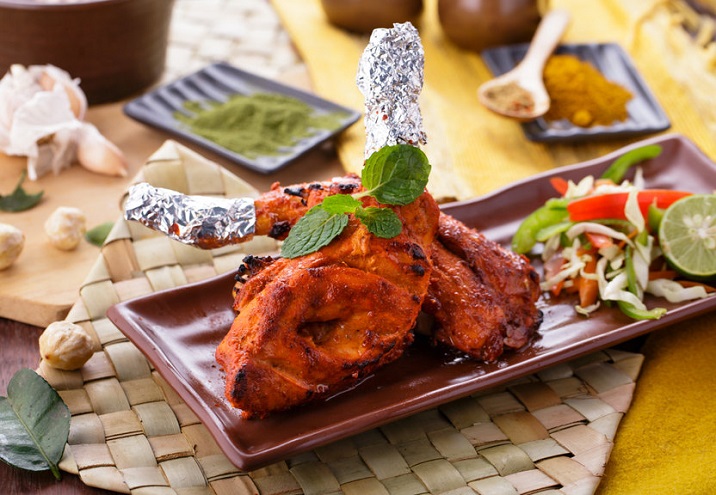
Indian food is eaten using one’s clean fingers because that way, the flatbreads are easy to portion. The spoons and forks are used for having snacks, curries, stews, rice, curds, or sweets when the need arises. Authentic Indian food is generally served in copper or brass bowls and plates or you can have it on fresh banana leaves or Patravali (Plates made of dried leaves), which help to save efforts of cleaning and disposing.
A few popular Indian foods are −
- Poha (beaten rice soaked and cooked by adding chopped vegetables and cilantro)
- Aloo Bonda (Boiled, mashed, and flavored potatoes enwrapped with lentil flour and deep fried)
- Kadhai Panner (Savory cubes of cottage cheese in thick tangy curry or gravy)
- Veg Kolhapuri (Wholesome vegetables cooked in spicy red gravy)
- Rajma (Black beans cooked in spicy gravy)
- Biryani (Aromatic and flavored rice dish cooked with vegetables or meat)
- Sarson-da-saag (Mustard leaves cooked with chili, garlic, and mustard oil)
- Jalebi (Coils of flour batter deep fried and dipped in sugar syrup)
- Gulab Jamun (Deep fried balls of milk powder and flour soaked into sugar syrup)
French Food Menu
France boasts of a wide range of cuisines. The cuisines follow authentic traditional cooking practices. French food caters to the preparation of appetizers, salads, soups, stews, side and main dishes, and desserts. A large variety of classic food is prepared using red and white meats. Recipes have evolved with seafood, fruits, cheeses, vegetables, pastries, and chocolates using authentic sauces and dressings.
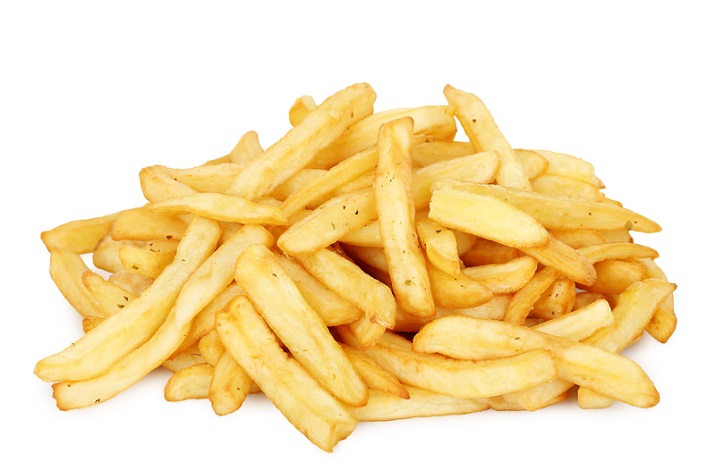
The following are some traditional French dishes are −
- Soupe a l'oignon (Onion soup in meat stock)
- Petits Pates a la Sage (Little pies of sage)
- Ratatouille (Traditional vegetable stew)
- Coq au vin (Rooster in wine)
Italian Food Menu
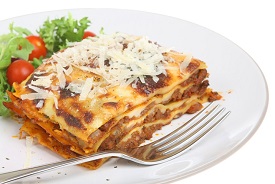
Italian food boasts of classically prepared pizza bases baked with savoury toppings of vegetables, meat, and cheese. It also includes a wide range of pastas of various shapes and sizes cooked and served with authentic Italian accompaniments and sauces.
The local customs of baking and cooking provide a large array of soups, salads, snacks, meals, and desserts from Italian cuisine. The food is often accompanied with beverages such as wine, champagnes, or other similar drinks.
The following are some popular dishes in Italian cuisine −
- Bellini (a cocktail made with white peach puree and sparkling wine.)
- Caprese Salad
- Cacciuco (Seafood stew)
- Risotto Alla Milanese (Saffron Rice)
- Arancini Veneziani (Venetian Rice Fritters)
- Braciola (Italian Beef Rolls in Tomato Sauce)
- Spinach and Mushroom Lasagna (Baked sheets of flour separated by stew and cheese)
Chinese Food Menu
They say, Chinese food is the tastiest in the world. It includes soups, snacks, and meals prepared with rice, noodles, vegetables, meats, seafood, sauces, and seasonings. The stir frying manner of cooking brings crunchiness, texture, and adds a great flavor to various Chinese dishes.
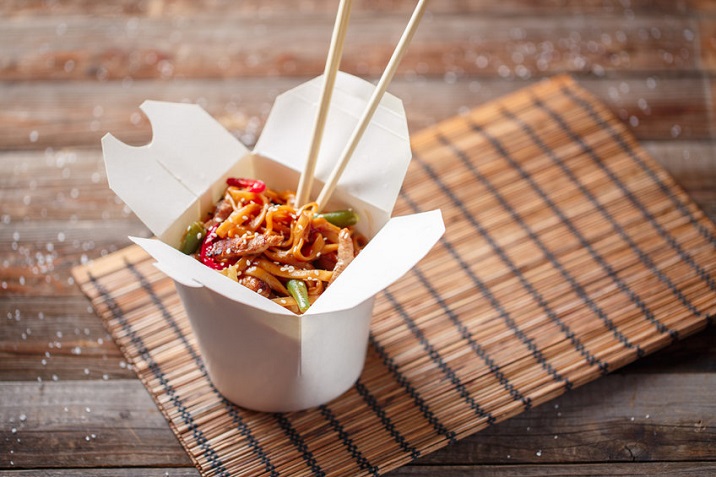
Chinese food is prepared with crunchy or leafy vegetables, bean sprouts, a variety of mushrooms, bamboo shoots, tofu (soybean curds), and spices such as chilies, ginger, Chinese celery, and garlic. The food is consumed using traditional chopsticks and spoons. The table setting displays porcelain bowls and spoons for soup, a large bowl for food kept on the flat plate underneath, Rice bowl, and a pair of chopsticks with resting stand.
The following are some traditional Chinese dishes −
- Gong Bao Chicken (Diced chicken cooked with dried chili and fried peanuts).
- Ma Po Tofu (Tofu cubes cooked with pepper powder, ground beef, and green onions).
- Wontons (Triangles of flour added in soup).
- Dumplings (Small dough disks filled with minced meat or spicy chopped vegetables, closed, and steamed).
- Spring Rolls (fried cylindrical rolls that enwrap minced meat or vegetables).
- Chow Mein (Cooked and stir fried vegetables in savory sauce).
Chinese food includes a cup of tea as beverage. No aerated drinks are served as part of authentic Chinese meal. Desserts are not commonly consumed in Chinese cuisine except on special occasions. The meal is generally completed with fruits.
Thai Food Menu
Thai food is popular for the aroma it brings with the addition of lemongrass, lemon leaves, galangal, chili, and aromatic herbs. The base food is vegetables, meats, eggs, sauces, noodles, and rice. A complete Thai meal comprises of snacks, salads, soups, one-dish meals, and desserts. It makes a blend of great taste and treat for eyes too.
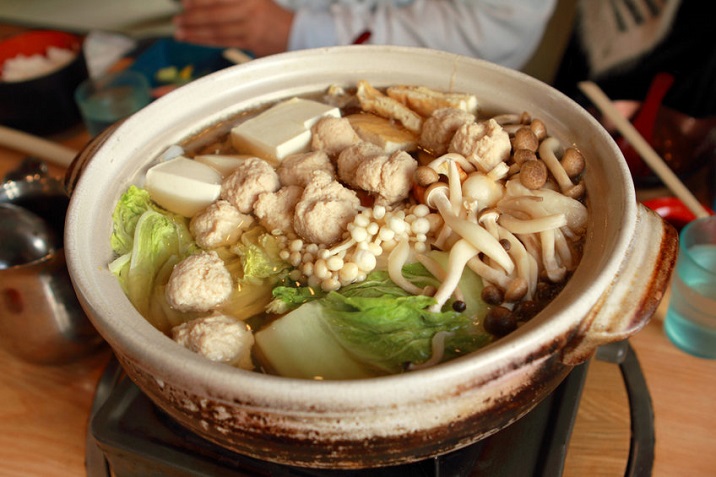
As per the traditional customs, the soups are enjoyed along with rice and noodles; not before. The rice or noodles are topped with the toppings of choice and consumed with spoon. Some popular Thai dishes are −
- Tom Yam Goong (Jumbo prawns in savory hot and spicy sauce)
- Pad Thai (Noodles with tofu, sprouts, fried onion, chili sauce, and finely powdered peanuts)
- Kuay Tiew (Noodles served in vegetables and meat broth)
- Gai Med Ma Moung (Chicken in soy sauce, garlic, honey, and cashew nuts)
- Kao Phad (Fried rice)
- Massaman Curry (Meat and potato cooked in cinnamon flavored curry)
Mexican Food Menu
Mexican line of food is famous for spicy and tangy taste. It includes salads, snacks, one-dish meals, elaborate meals, and desserts.
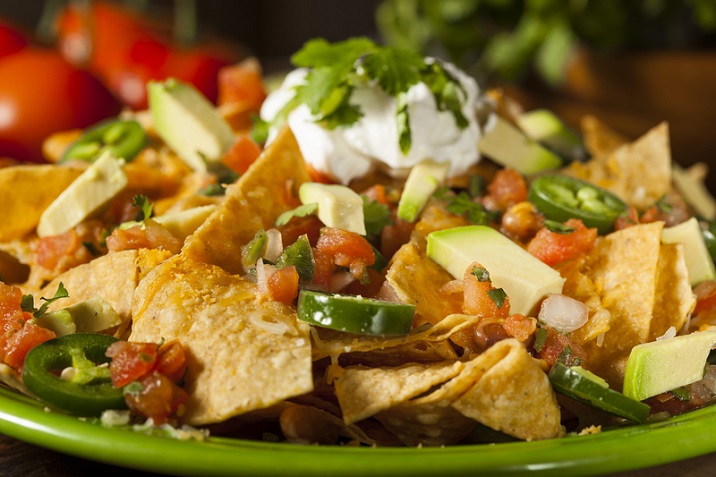
The basic food items in Mexican cuisine are −
- Tortillas (Corn flour or wheat flour disks)
- Fajitas (Grilled meat on tortilla)
- Tacos (Small tortilla partially enwrapping the filling)
- Quesadillas (Wheat or corn tortilla filled with cheese and meat or vegetables)
- Nachos (A Texan-Mexican or Tex-Mex snack with savory flavored tortilla chips)
- Enchiladas (Corn tortillas rolled around a filling of cooked meat, seafood, beans, or vegetables and covered with a chili pepper sauce and cheese)
- Empanadas (Baked or fried stuffed bread or pastry)
Corn, black beans, native fruits and vegetables, herbs, and meats are integral ingredients of Mexican food. A few popular Mexican dishes are −
- Chicken-mango-jalapeno salad
- Mango-pineapple salsa
- Prawn fajita with avocado cream
- Mexican chicken stew
- Grilled chicken nacho
Food and Beverage Services - Menu Courses
The courses of meal around the world vary in number from as small as just one to as wide as 17, in case of a traditional French meal. The courses are divided according to what food one eats. There are different food profiles according to the country’s culture and customs. Generally, there are at least three courses of a meal −
Starter
In this course, a welcoming appetizer that induces hunger is given to the guests. Also, the guests can prefer soups accompanied with the bite-size savory snacks as side orders in this course.
Main Course
During this course, main dishes with vegetables or meats accompanied with rice and breads are served. In some cultures, such as Indian, the main dish is accompanied with salads.
Dessert
This course signals the end of meal and is usually had with a cup of coffee.
Salads form an important part of diet in France. A typical French meal has an addition of Salad Course. It is often accompanied by other courses such as Fish Course and Cheese Course. There are cultures where people prefer to take one dish meal with no elaborate and distinguished courses of food.
Broad Types of Menus
Depending upon what and how the food is made available to the guests, there are following broad menu types −
Table D’hote Menu
Table D’hote is a menu where the meal is combined with a number of food options from each course. The guests can make their choice and order for a fixed price. Irrespective of what the guest chooses or declines, the price remains the same. Hence, it may also be called prix fixe or fixed price menu. Banquet menus, children’s menus, and occasion menus cater to special occasions and are offered at a set price.
A la carte Menu
A la carte is a multi-course or multi-category menu that comes with appetizers, starters, sea-food, meats, side dishes, beverages, and alike. Each dish is offered at a separate price. The guest can choose individual dishes to make own meal package.
Static Menu
In this menu, the typical types of meals are served yearlong with an occasional change on some special days.
Cyclic Menu
Cycle menu includes different meals offered on different days of a week. The cafeterias at educational institutes and otherwise use this menu which they can repeat after a week or a month. Serving a feast on Sunday, offering special variants of chicken on Fridays can add to the cyclic menu.
Let us now look at a few other menus which boost your platter and the F & B Services.
Dessert Menu
This menu displays puddings, cakes, tarts, ice creams, smoothies, fondues, sundaes, sweet pies, and ice creams and frozen yogurts along with their respective prices.
Frozen Desserts − They are usually popular with people from all ages and walks of life. They are always served chilled. The following are some mouthwatering frozen desserts are −
Ice Cream/Gelato (Italian for ice-cream) − They are primarily same with just a little difference in composition of milk, custard, water, and eggs. In India, frozen desserts are prepared with thick full cream milk and fruit pulp or crushed nuts and saffron. It is popularly known as ‘Kulfi’. Kulfi is served on stick or in terracotta pot called ‘Matka’.

Sorbet − It is a frozen dessert made of fruit juices, dessert wines, and ice shaves. It is flavored by a variety of edible food colors and essences. In contrast to ice cream, frozen dessert appears icier than milky.
Frozen Yogurt − It is made by freezing flavored yogurt. It also contains less fat, sugar, and thus less calories as compared to ice creams.
Beverage Menu
This menu includes variants of tea and coffee, hot chocolate, juices, milkshakes, mocktails, and so on. The wine menu includes wines, beers, liquors, types of water, cocktails, and spirits with their respective serving quantities and prices.
Food and Beverage Services - Beverages
Beverage is any liquid consumed by humans for quenching thirst, or merely for pleasure. Beverages come in various types −
Non-Alcoholic Beverages
There are two types of non-alcoholic beverages.
Hot Beverages
These are served hot. Hot beverages typically include tea, masala tea (spiced tea), milk, hot chocolate, and variants of coffee such as expresso, latte, and cappuccino.
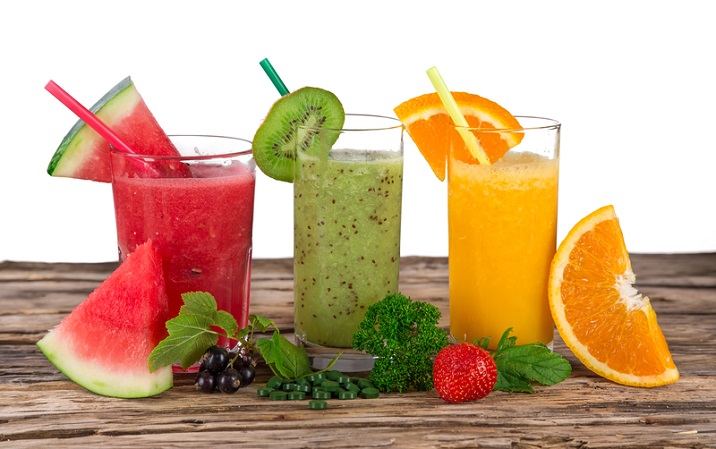
Cold Beverages
These are served and consumed while chilled. Cold beverages include juices, mocktails, coolers, cold versions of tea and coffee, milkshakes, carbonated drinks, mocktails, and sherbets. The following beverages are famous in countries like India −
- Buttermilk with a dash of powdered cumin seeds and salt.
- Aam Panna, a sweet and sour raw mango juice with a dash of cardamom in it.
- Tender coconut water locally called Nariyal-Pani.
- Sol Kadhi, thin coconut milk flavored with Kokum and ginger-garlic-chili paste.
There are a few cold beverages which come as cocktails and are prepared using alcohol.
Alcoholic Beverages
These are served cold. Alcoholic beverages are intoxicating and contain ethanol, commonly known as alcohol. Such beverages need to undergo fermentation and distillation to generate alcohol contents. The percentage of alcohol varies in the range of 0.5% to 95% depending upon the methods of fermentation and distillation.
- Wine, Cider, Perry, and Champaign are fermented alcohols.
- Beer, ale, and lager are fermented and brewed alcohols.
- Gin, Vodka, Whisky, Rum, Brandy, and Tequila are distilled alcohols.
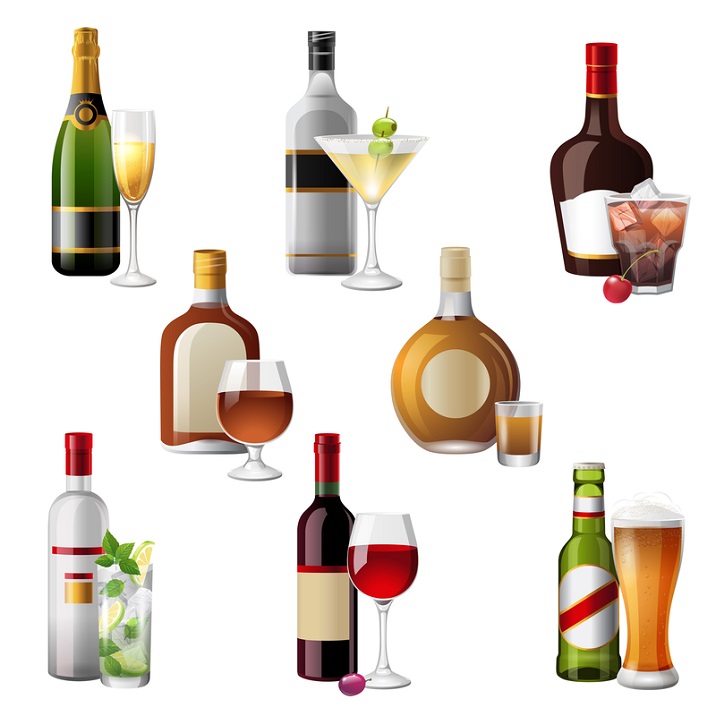
If a beverage contains at least 20% Alcohol by Volume (ABV), it is called spirit. Liquors are similar to spirits. The only difference is that liquors come with added sweetness and flavoring. Liquors and spirits, both are strong alcoholic beverages. The following are a few most popular alcoholic beverages −
| Beverage | Process/ Raw Material | Origin | Alcohol by Volume (ABV in %) |
|---|---|---|---|
| Beer | Beer is obtained by fermenting liquid mixture of cereals such as corn, rye, wheat, barley and yeast. | Throughout the world. | 5 – 10 |
| Brandy | Brandy is obtained by distilling the fermented fruit juices. | 40 – 50 | |
| Gin | Gin is obtained by distilling the fermented juice of Juniper berries with water. | Holland | 40 – 50 |
| Rum | Rum is obtained by fermenting Sugarcane juice or Molasses for at least three years. | Central/South America | 40 – 55 |
| Tequila | Tequila is obtained by distilling fermented juices of Blue Agave plants. | Mexico | 40 - 50 |
| Vodka | Vodka is prepared by distilling starch or sugar-rich plant matter. | Russia | 35 - 50 |
| Whisky | Whisky is prepared by distilling fermented juice of cereal grains. | Scotland | 40 - 55 |
| Wines | Wines are obtained from fruits such as grapes, peaches, plums, apricots, pomegranate. The fruits are crushed and fermented in large containers. | France/ South Africa/India | 5 - 20 |
Due to the unwanted side effects of alcohol on consumer and the society, it is the responsibility of food and beverage service staff to verify the young customer’s age before serving alcoholic beverages.
Food and Beverage Services - Equipment
The equipment forms an inevitable part of food and beverage service. It plays an important role to build the mood of the guests, to complement the outlet theme, and to elevate guest experience. Right from the largest commodities used for food preparation and interior decoration such as chandeliers or ovens to the smallest piece of cutlery, furniture, or linen participate in creating overall ambience of the outlet.
Let us discuss in detail the equipment used in food and beverage services −
Furniture in F&B Services
Furniture is an important part of any F&B Services outlet. It needs to be strong, easy to use and clean. The furniture plays an important role in bringing the look and creating an ambience of the outlet. The furniture, fixtures, and fittings are fixed commodities.
Indoor Furniture
It mainly consists of tables, chairs, push-down chairs, racks, and lockers.
Outdoor Furniture
It needs to be sturdy as well as attractive. It includes coffee tables and chairs, bar chairs, dining sets, day beds, loungers, hammocks, and swings.
Fixtures and Fittings
A fixture is any item bolted to the floor or walls. For example, air conditioners, electric plugs, sinks and toilets, art pieces, and television screens mounted on wall are fixtures.
A fitting is any free standing item or an item that can be hung by a nail or hook. For example, paintings, mirrors, curtain rails, and lamps are fittings.
Tableware in F&B Services
Tableware consists of crockery, cutlery, glassware and linen used while serving and eating meals at a table. These are circulating equipment which can be grouped into the following types −
Chinaware
This is a collection of fine dishes, bowls, food platters, section dishes, ramekins, cups and saucers, soup spoons, vases, and ash trays made using a translucent ceramic material.
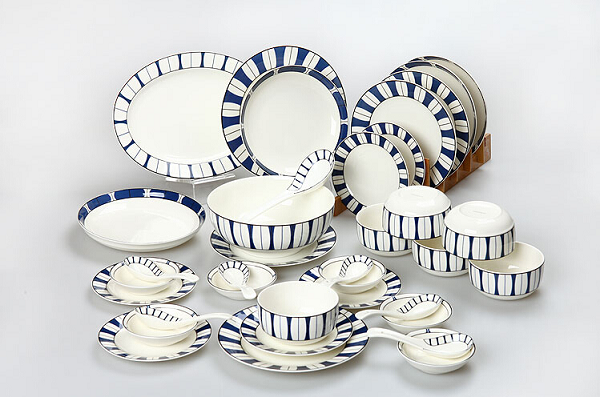
Hollowware
This consists of containers such as serving bowls, pots, kettles, ice jugs, and water. These containers are either made from glass or metals such as copper, brass, or stainless steel.
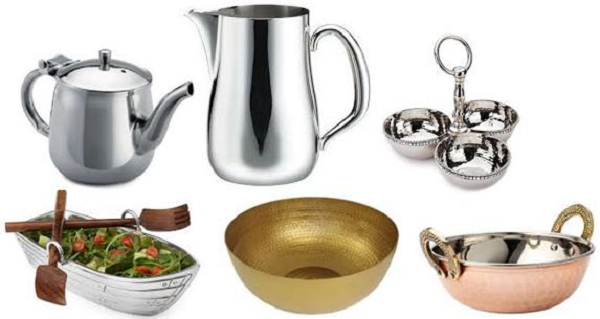
Glassware
This consists of articles made of fine glass. Glassware includes jugs, pitchers, drinkware, ash trays, vases, and similar articles.
Silverware
The objects in silverware are made of Electro Plated Nickel Silver (EPNS). These are made from an alloy of brass, zinc, stainless steel or nickel with silver plating of 10 to 15 microns. Silverware includes spoons, forks, knives, hollowware, drinkware, tongs, ice bucket, and a salver.
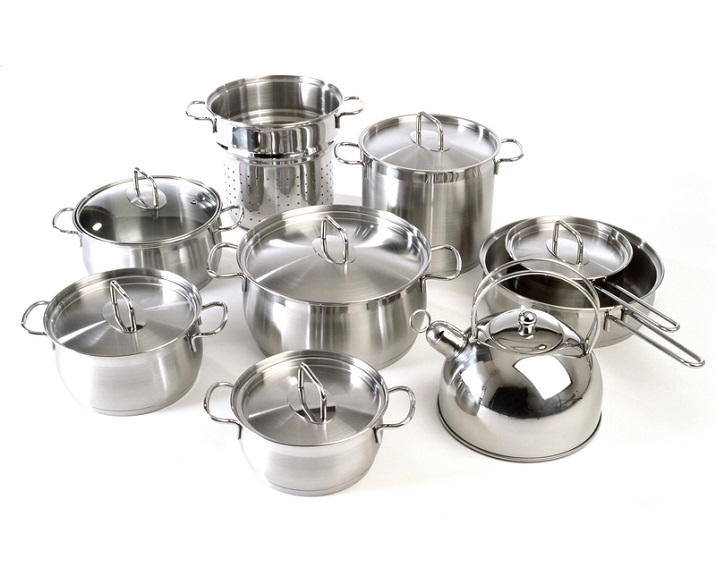
Chaffing Dishes (Chafers)
These are food warming dishes. They keep the food warm for an adequate time and temperature. They come in two variants: electric or chafer fuel candle.
Chaffing dishes are available in multiple sizes, shapes, and lids. Modern-day chafing dishes are made of light metal or ceramic with handles, sometimes covered with a see-through lid. Here are some chaffing dishes −

Food & Beverage Services - Use Of Cutlery
Cutlery comprises of any hand-held implement for eating or serving food. It includes various spoons, forks, knives, and tongs. It is also called silverware or flatware. Cutlery is made of metals like stainless steel or silver.
In modern days, cutlery has come up in wonderful combinations — spife (spoon + knife), spork (spoon + fork), and knork (knife + fork).
Types of Spoons, Forks, and Knives
There are different types of spoons for serving or eating different kinds of food. The forks often accompany spoons or help independently to pick food bites. The knives are used to portion the food.
- Dinner Spoon (Table Spoon) − It has elongated round cup. It is used to eat main course food items. It can pick up just the right amount of rice, stew, or curry. It is always paired with a fork (with four tines) of the same length or a dessert knife.
- Dessert Spoon, Dessert Knife, and Dessert Fork − These are smaller than their main course peers and are used to have desserts.
- Soup Spoon − It has a round cup bigger than that of the table spoon. It is as long as a dinner spoon.
- Tea/Coffee Spoons − These are smaller than the dessert spoon in length and size of cup. We use these spoons to stir tea or coffee.
- Sugar Spoon − It has a flower shaped round cup. It is used to take sugar from sugar bowl of tea set.
- Ice Cream Spoon − It is a small spoon with flat rim that can help to cut the right amount of ice cream. It can come in small, medium, and large sizes according to the quantity of the ice cream served and the size of the bowl.
- Cocktail (Soda) Spoon − It is a drink spoon with a long handle that helps the spoon to reach the bottom of a tall glass.
- Butter knife − It has short rectangular blade that is sharp on the lower side to form an edge. It is useful in cutting semi-firm pieces of butter and apply them on food items such as breads.
- Salad Spoon − It is always used in pair with salad fork. It helps mixing and serving salad efficiently.
- Serving Spoon − It is a spoon with large round cup designed to serve stews and rice.
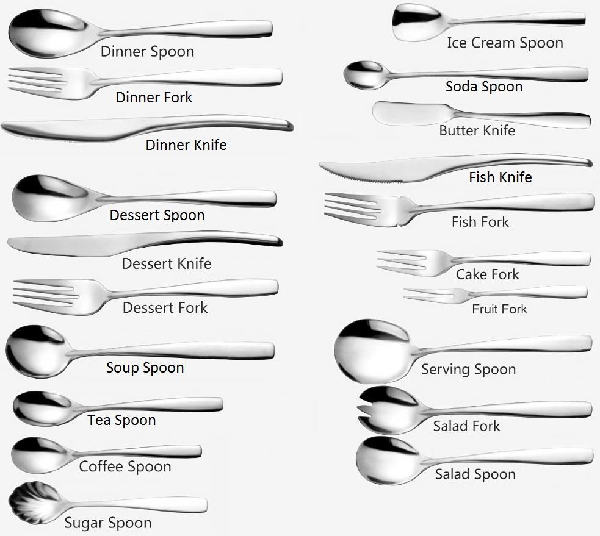
- Deli (Fruit) Fork − has two tines. It helps to pick thinly sliced food such as slices of fruits.
- Roast Fork − It is the largest fork. It has longer and stronger tines that help to hold and pick large meat or vegetable pieces.
- Cake Knife − It is a flat, elongated triangle-shaped knife and is used to cut pieces of cake and handle it smoothly.
Types of Glasses
The glasses and tumblers come in a wide variety of shapes and sizes. They are either footed with stem or non-footed. They can also be high-ball or low-ball. Some of the widely used shapes are −
- Cooler − It is used to serve welcome drinks or appetizers.
- Flute − It is a glass with a long cup and is mainly used to serve champagne.
- Goblet − It is a round glass with or without stem. The goblets with stem are used to serve wines and brandy. A non-footed version is used to serve whisky.

- Margarita − It is a variant of goblet with a wide round dish-like cup. Margarita is used as a cocktail, mocktail, or a sorbet glass.
- Mug − It is used to serve beers.
- Nonic Glass − It is a tall glass with a broad rim. It is used to serve beers.
- Pilsner − It is a high-ball glass used to serve cold coffee, iced tea, juices, and beer. A pilsner can support beers or aerated drinks gracefully.
- Pint − It is a glass used to pour distilled alcohol into other glasses.
- Shot Glass − It is a small glass used to consume fermented or distilled alcohol directly. It can also be used to pour distilled alcohol into other glasses for mixing with water or sparkling water.
- Snifter − It is used to serve spirits.
- Thistle Glass − Its silhouette is shaped like a thistle flower. These glasses have tapered broad rims with round cups attached to a stem and disk. It is used to serve ales and aerated drinks.
- Tulip Glass − It is used to serve beer, cocktail, or mocktail.
Food & Beverage Services - Use Of Linen
The linen at any food and beverage service outlet is either disposable or non-disposable.
Disposable Linen
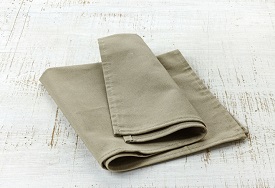
This includes items that can be used only once. These items are made of recycled paper with high absorbing capacity. For example, table napkins, restroom tissues, wrappers, and facial tissues. Facial tissues soaked in Cologne water are given to the guests. It is considered a good welcome gesture. Disposable table linen is usually offered to guests in trains or aircrafts before meals.
Non-Disposable Linen
The items in this category are made from flax. This includes table cover, dinner napkins, tea napkins, and table runners. Non-disposable linen must be clean and pleasantly scented. It must be starched if required.

Non-Disposable linen must be placed on the table tidily. The staff can fold them and arrange them in decorative shapes or just put them through decorative linen rings to catch guests’ eyes and start imparting warm experience to them at the table.
F & B Services - Pantry Equipment
Pantry is the adjoining area or room to the kitchen from where the finished food or a drink is ready to be served. This area serves as an ancillary capacity of the kitchen. The food is given final touch-up for presentation, and then handed over to the serving staff. The pantry is often equipped with a sink attached with normal water and hot water taps. The pantry mainly keeps the following necessary items −
- Refrigerator
- Electric oven
- Toaster
- Coffee Brewing Machine
- Blender
- Electric food whisk
- Knives and chopping boards
- Hollowware like casserole, bowls, and dishes of various sizes
- Crockery
- Drinkware
- Cutlery
Sideboards in Pantry
Sideboards are mainly shelves with drawers. These can be used to store hollowware and glassware. The following are the different varieties of sideboards −
- Buffet − It has high legs than the sideboard.
- Credenza − They are the storage cabinets without legs. They mostly have sliding glass doors.
- Server − A server is smaller, shorter, and more formal than a buffet or sideboard.
- Sideboard − It has short legs.
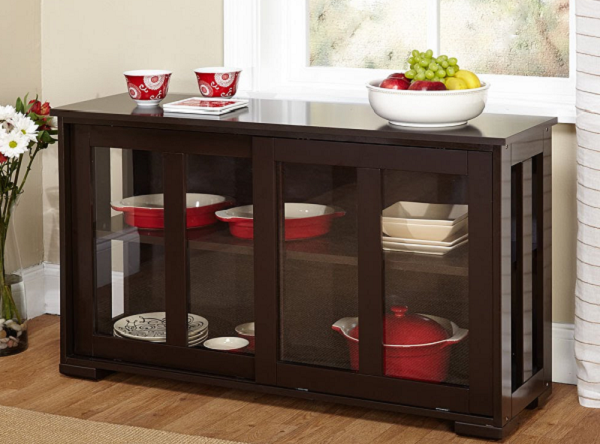
Trolley
It is a serving cart used for serving as well as storing. It has wheels which enable it to move easily around the kitchen. It is also used in elite food and beverage outlets for serving the guests. It is available in various designs, sizes, and shapes. You can choose on number of shelves and sections, and burners. When not in use, it is preferably parked at the wall.

F & B Services - Cleaning & Maintenance
When the food is ready to arrive in the pantry, used utensils for food preparation are cleaned immediately and wiped off dry for later use. If any other ancillary serving item such as electric hand blender is damaged, it is reported to the concerned manager and replaced with a working one at the earliest.
When the guests complete their meals and leave the table, it is required to prepare the table immediately by clearing the used tableware. If any tableware is found broken or damaged, it is reported to the concerned store department and a request is made for its replacement. The table covers and runners are checked and replaced with fresh ones if need be.
The used tableware is handed over to the cleaning and washing staff. The linen is also handed over to the laundry department in the hotel. In case of other F&B Services businesses, the soiled linen can be stored separately and given away to contracted laundry service.
Point-of-Sale Equipment in F&B Service
Today, many restaurants use Point-of-Sale (POS) equipment, a computer-based technology to take orders, record them, accept payments, and display or print their receipts. Restaurant servers, bartenders, and cashiers can use POS systems to enter and record food and beverage orders easily.
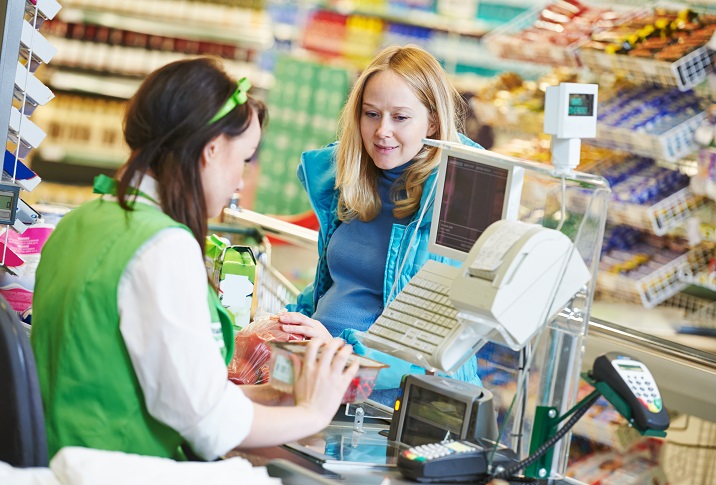
A POS system in the F&B Services can increase convenience and accuracy in order tracking, and can save time during rush hours. It can smoothly perform the following functions −
- Calculating cash due for every order entered for a table.
- Recording the method of payment.
- Tracking balance cash.
- Creating periodic sales reports.
- Calculating labor and payroll data.
- Recording daily check averages for each worker.
- Tracking the number of balance and sold food items.
- Recording information of repeat customers.
Food & Beverage Services - Food Garnishing
The guests’ experience of food and beverage starts when the serving staff brings beautifully garnished food with the appropriate accompaniments on their table. The service staff turns a guiding hand to the guests in suggesting which accompaniment will go well with the main food the guest is interested in having.
There are numerous interesting pairs of foods with their garnishes or accompaniments. Let us see in detail about garnishing, food accompaniments, and some typical food-garnishing paired with accompaniments.
What is Garnishing?
It is the way of decorating the food or beverage so that it is aesthetically appealing for the guests/customers. It works on the plate. Garnishing also harmonizes color, flavor, and taste of the main dish.
Chopped herbs or small twigs of herbs, leafy vegetables, twirls of carrots or tomatoes, swirls of fresh cream, fruit glaze, chopped nuts, seedless berries, and lemon zest or slices are used for garnishing.
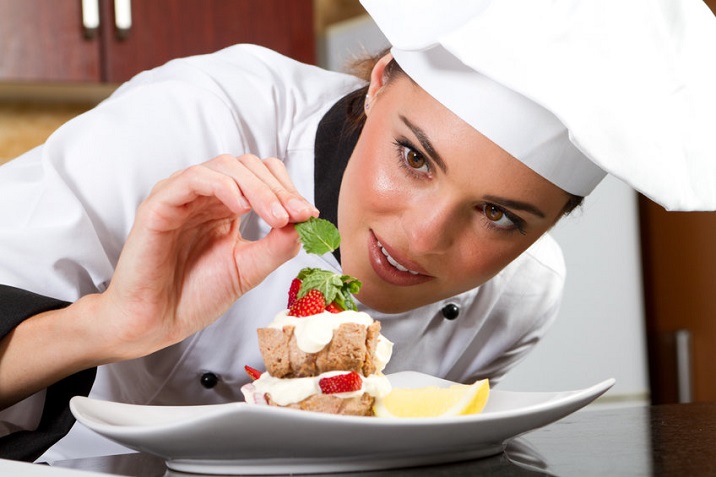
Desserts are garnished with dried fruits, fresh fruit zests, glazes, roasted or candied nuts, frostings, chocolate curls, chocolate coated buts, or small pieces of sugar arts.
Drinks like cocktails and mocktails are garnished using fruit pieces and zests, mint leaves, and castor sugar. Milk based drinks are garnished mostly with fruit pieces, cherries, chocolates, or nuts.
Do’s and Don’ts of Food Garnishing
The following are some important Dos and Don’ts to be understood in food garnishing −
- Place it where it seems just perfect.
- Contrast color schemes work best for garnishing.
- Do not overdo garnishing; this overshadows the main food.
- Do not reuse the garnish.
- Avoid being too elaborate.
What is Accompaniment?
There are dishes that come along with accompaniments. These accompaniments complement the main food and enrich its taste. It provides an aesthetic value to the main dish. The accompanying food or beverage itself can have a garnish of its own. An accompaniment can be inside the main dish or in a separate bowl.
The following are a few different types of accompaniments −
- Sauces and Dips
- Pickles
- Dressings
- Chips and Wedges
- Salads
- Gravies
- Beverages such as soft drinks or wines
- Breads
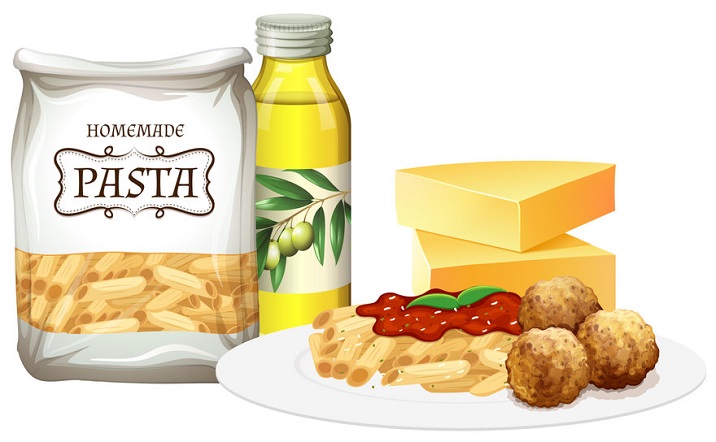
For example, grilled Hake fish served with potato chips and Pizza served with garlic bread, cheese dip, and a carbonated beverage.
Popular Food Items with their Accompaniments
The following are a few popular food items with their garnishing and accompaniments −
| Food/Dish | Garnish | Accompaniment |
|---|---|---|
| Soups | Chopped Cilantro/Fresh leaf of Basil/Croutons/Cream swirls | Salads/Breads/Crispy starters |
| Bouillabaisse | Chopped herbs | Country bread slices spread with Rouille, a spicy mayonnaise. |
| Farineaux Spaghetti | Fresh basil leaves | Grated cheese, pepper powder, and Neapolitan tomato sauce. |
| Veg/Non-veg burger | Not essential | Potato/ Sweet potato chips, aerated drinks or ale. |
| Indian Snacks Idli, Vada, and Dhokla | Chhonk of clarified butter with mustard and cumin seeds, and curry leaves. | Coconut-Cilantro-Green Chili Chutney. Idli and Vada are often accompanied with lentil curry called ‘Sambar’. |
| Indian Onion or Chili Fritters (Pakoras) | Not essential | Tomato sauce or hot and sour chutney. |
| Mutton/Chicken/ Veg Biryani | Chopped coriander and caramelized onion stripes. | Liquid gravy with lemon wedges and onion-tomato-cucumber salad in curds. |
| Indian one dish meal Pao-Bhaji (Pao=bread, Bhaji=Spicy Stew) | Pao is garnished with butter and Bhaji with chopped cilantro and butter. | Onion-Tomato-Cilantro salad with lemon wedges and mango pickle. |
| Barbequed/Braiied Beef/Game Meat | Herbs | Sauces |
| Roast Beef | Herbs, Butter | Horse Radish sauce |
| Fruit Salad | Castor Sugar | Yogurt |
| Irish Stew | Herbs | Worcestershire sauce and Pickled red cabbage. |
| Poulet Grille Americain (American Grilled Chicken) | Herbs in butter. | Addition of grilled dices of tomato, mushroom, capsicum, and potato. |
| Sage and Onion Stuffed Goose | Pieces or Stripes of salad vegetables. | Apple sauce and roast gravy. |
| Fromage Assorti (Assorted Cheese) | Castor sugar for crème cheese. | Celery, Radish, Water Crest, and Cracker Biscuits. |
| Veg/Non-veg Stew | Chopped fresh coriander | Steamed Rice or Bread |
| Ice Creams | Vanilla/Chocolate/Raspberry/Strawberry Sauce, chopped nuts, Colorful candies, Rose Petals | Waffle sticks or stripes. |
Cheese and Wine Pairings
There are no stringent rules for which wine goes well with which cheese but one must observe the following guidelines while pairing wines with cheese −
- Select wine and cheese originating from the same region.
- Dessert wines accompanying the desserts must be sweeter than the dessert itself.
- Cheeses go well with wines of contrast taste.
| Wine | Cheese |
|---|---|
| Champagne Brut, Extra Brut (Dry) | Brie, Camembert |
| Champagne Sec, Demi-Sec, Doux (Sweeter) | Cheddar, Gouda, and Parmesan |
| Shiraz | Cambozola |
| Red Bordeaux | Cheddar |
| Chenin Blanc | Blue, Camembert |
| Pinot Blanc | Baby Swiss, Brie, Camembert, and Feta |
| Cabernet Sauvignon | Blue, Cheddar, Gorgonzola, Gouda, and Parmesan |
| Cabernet Franc | Blue, Brie, Cheddar, Gorgonzola, and Goat Cheese |
| Chianti | Mozzarella and Parmesan |
| Port (hails from Portugal and sweeter than other wines) | Blue and Gorgonzola |
Chocolate and Wine Pairings
Lighter chocolates contain more milk based-products and less chocolate. Chocolates with light and elegant tastes are paired best with light-bodied wines. The ones with more bitter taste are paired with intense flavored full-bodied wines.
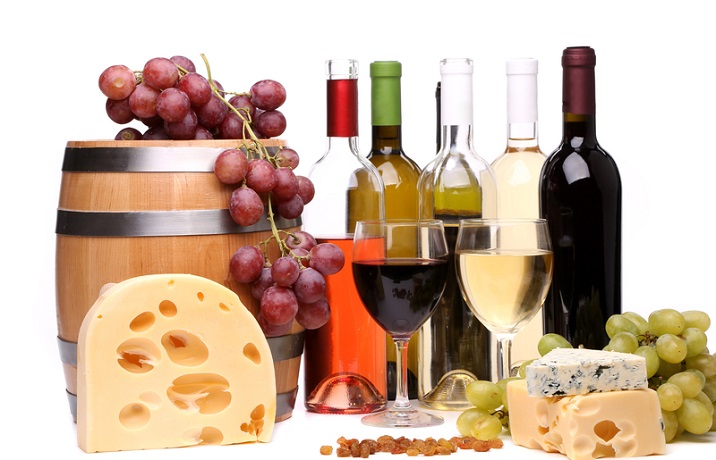
Standardized Recipes
A critical standardized recipe is one that, “has been tried, adapted, and retried several times for use by a given food service operation and has been found to yield the same good results under same procedures, equipment, and quantity and quality of ingredients.”
Generally, popular menu items are developed using standard recipes, ingredients, and presentation.
Benefits of Standardized Recipes
A standardized recipe can bring in the following benefits −
- Consistency in food quality.
- Consistency in nutrients per unit serving.
- Increase in customer satisfaction.
- Control on cost of food.
- Prediction of accurate yield.
- Reduction in food leftover and record keeping.
- Increase in the confidence of employees.
Components of a Standardized recipe
A typical standardized recipe is composed of the following description −
- Recipe name/title − It is the name that describes the recipe in brief.
- Recipe section − It is the section that the recipe should be classified under (grains, starters, desserts, etc.)
- Ingredients − Types (fresh/canned/cooked/uncooked/ground, etc.)
- Weight and measures of ingredients
- Method − This is a set of instructions to prepare a particular recipe. A method includes guidelines for steps such as mixing, selecting pans, and setting the right cooking temperature.
- Time − This includes preparation time, cooking time, and serving time.
- Serving size − It is the portion of food to be served.
- Critical Control Points (CCP) − They are control measures taken to avoid food safety hazards. Every CCP includes control of time, preparation, and cooking temperature.
Critical Standardized Recipes
Predicting the total yield for a particular number of customers and calculating weights of ingredients accordingly is important in standardized recipes.
For recipe to be prepared for new lot of customers, the total yield changes. The new yield can be calculated in the following two steps −
Step 1 − Calculate conversion factor as −
Conversion Factor = New Yield / Old Yield
Step 2 − Multiply the measure of each ingredient by the conversion factor to obtain the new yield −
New Yield = Old ingredient quantity x Conversion factor
F & B Services - Beverage Service
Beverages play an important role in accompanying food. Beverages also enhance flavor of main dish and help to cleanse the taste buds in between bites, and complement the dish.
Hot beverages such as hot tea or coffee, and hot chocolate are prepared in the kitchen and generally served from the kitchen pantry. Cold beverages such as mocktails and alcoholic beverages such as spirits, liquors, and cocktails come to the guests’ tables from bars.
Types of Bars
A bar is a place where non-alcoholic and alcoholic beverages are served. It is equipped with a back bar with necessary equipment such as bar tools, and glassware to serve the beverages. The customers sit on tall push-down chairs around the counter. The barmen or barmaids commonly known as bartenders prepare drinks and serve them to the customers. There are some typical types of bars −
- Public − It is a bar in a public house which is open for public and not exclusive.
- Service Bar − It is for the staff.
- Portable − They are compact bars easy to set up for off-premise catering.
- Mini − It is a private bar located in VIP rooms, suites, or penthouses of the hotel.
Bar Tools
The following tools are necessary to serve beverages from bar −
- Bar Linen and Cocktail Napkins − They are used to save work area from any mess while pouring the beverage.
- Pouring Spouts − They make smooth serving of beverage apportioned equally into the glasses.
- Juice Containers − They are useful to save bartending time by keeping most demanded juices handy.
- Cocktail Shaker Tins − They are suitable for mixing the ingredients of cocktails and martinis well.
- Short Shaker Tins − They are used to shake small amount of drinks efficiently.
- Cocktail Strainer − It is used to sieve cocktails before serving.
- Corkscrew or Wine Opener − They are used to open corks of wine bottles.
- Bottle Opener − They are used to open caps of bottled beverages.
- Jigger − It is an alcohol measuring two-sided cup.
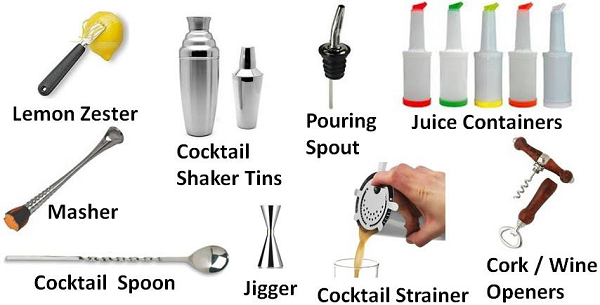
- Lemon Zester − It is used for cutting lemon zest.
- Bar Spoon − Also called muddler, is used for mixing beverages briefly.
- Masher − It is used to mash ingredients to help release oils and flavors effectively.
Dram Shop Liability
The Dram Shop Liability in US is the body of law that governs the liability of alcohol stores and the commercial establishments where alcohol is served. This body endeavors to protect the society from the unpleasant outcomes of serving alcohol to minors and intoxicated people.
Verifying Legal Drinking Age
The legal age of drinking alcohol is different in different countries. The minimum age to purchase and consume alcohol ranges from 16 years to 25 years. In some countries, this age limit varies according to strength of the alcohol, premises of consumption, or whether the young customer is accompanied by an adult.
When the customer looks underage, the beverage serving staff is compelled to ask for the customer’s driving license or any reliable identity card from a well-recognized institution as a proof of age before serving the alcohol.
Monitoring Alcohol Intake
It is up to the serving staff who has had enough drink as the drunk persons themselves often fail to be composed and know their own state. To keep the account of how much the customers are drinking, the bartenders must use standard measures for pouring drinks.
Cutting off Alcohol Service
The bartending staff needs to cut off alcohol service if the customer is on the way of binge drinking and seems not able to handle it. Refusal of alcohol service should be −
- Executed professionally by speaking firmly and clearly with the drunk/under-aged customers.
- Denied quietly without notifying other customers.
Food and Beverage Services - Preparation
Imparting an out of the world meal experience requires a lot of preparation beforehand. Food and beverage businesses work to bring out the best possible experience for their guests and customers to achieve maximum customer satisfaction. All operations regarding food and beverage service need preparations by anticipating guest arrival at any time during working hours.
Let us see what all basic preparations are required to be done.
Mise-en-scene
It is the activity of preparing the environment in the F&B Services establishment so that the guests and the service staff find it hygienic and pleasant.
To prepare the environment, the staff carries out the following activities −
- Opening all windows and doors before working hours to let fresh air and sunlight enter the venue.
- Ensuring menu cards and promotional material are presentable.
- Removing the furniture that needs servicing and handing it over to the maintenance department or any outsourced agency.
- Vacuuming carpets if any.
- Switching on all lamps to check the fused ones.
Mise en place
It is the activity of putting things in place to make the subsequent F&B Services smooth. The serving staff carries out the following duties −
- Removing all soiled linen and replacing them with the fresh ones.
- Ensuring that the side board is well-equipped.
- Replenishing condiment containers, shakers, and water jugs.
- Polishing cutlery and glassware.
- Replacing pale flowers with the fresh ones.
Preparing Side Boards (Dumb Waiters)
It is a piece of furniture with numerous compartments and shelves to keep condiments, water jug or bottles, cutlery, food platters, and linens. Side boards are allocated for every station.
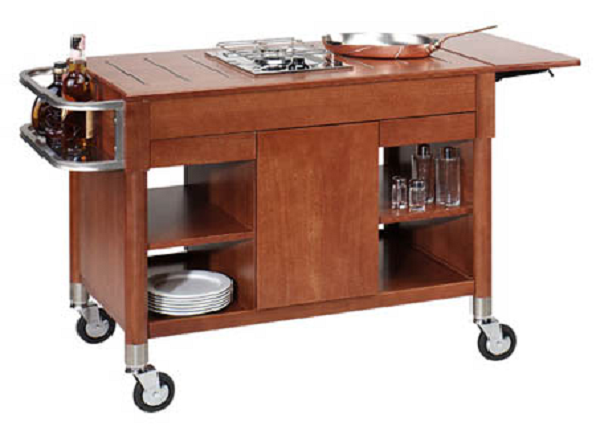
To prepare the side boards, the serving staff must place −
- The replenished containers of water, butter, and condiments.
- The dinner plates, side plates, glasses, mugs, and fingerbowls in the lower shelves.
- The linen, napkins, and dolly papers neatly and stalked.
- The cutlery in the appropriate sections separately according to the type.
- The condiments containers and shakers, water jug, butter dish, toothpick holders, straw holders, on the upper shelf or board.
Preparing Ice and Water
Ice and water are the preliminary requirements of any food and beverage service establishment. Clean drinkable water is obtained from the water purifiers installed in the service establishment. The purifiers are selected such that they can cater to large number of people per hour.
Crystal clear ice in the shape of large cubes can be prepared in-house if the size of F&B establishment is large enough to install the required equipment. The ice can also be purchased from an outsourced ice-making business and stored in the freezers.
When the guests are seated, they are first served water at adequate temperature according to the season.
F & B Services - Preparing The Table
Table setup plays an important role in contributing to the appearance of the table.
Principles of Preparing Covers
- Each table cover needs space of 24 to 30 inches wide.
- Crockery and cutlery must be placed 2 inches away from the edge of the table.
- Knives are placed on the right of the dinner plate whereas forks are placed on the left.
- Butter knife is placed on the side plate.
- The cutting edge of the knives must be towards the plate.
- Table napkin must be neatly folded and placed on the side plate.
Setting Table for Formal Dining
This type of table setup is required for formal events like corporate lunch or dinner, or a wedding party. The formal dining contains multiple courses and second helpings are not offered.
This table setup looks as follows −
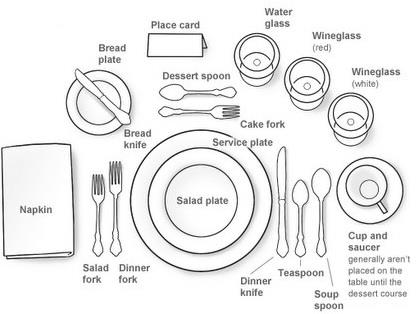
Setting Table for Casual Dining
This table setup is required for informal events like holiday parties and family gatherings. Casual dining can contain multiple courses and service staff offers or serves second rounds of helping when a guest requests for it. This table setup appears as follows −
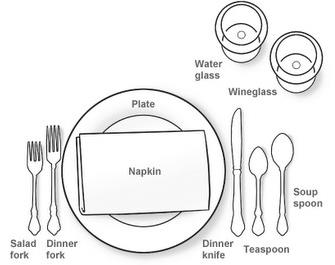
Setting a Buffet Table
This set up is required for catering to large groups of people. Buffet table setting can be done in numerous ways depending upon the size and shape of the place, the menu, and the number of guests.
- The food items are placed in a sequence from lightest to heaviest, starters to desserts, or coolest to warmest.
- Cutlery is placed on the guest tables.
- Glasses, cups, and saucers are placed on a separate table to avoid congestion.
- Table decoration pieces are placed such that they do not interfere with the food items.
- Plates are stacked not more than 15 plates per stack.
- Paper napkins are placed between the plates.
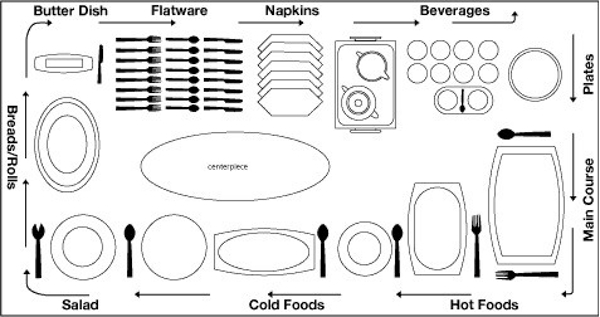
Preparing Condiments
The condiments are kept according to the theme of the F&B service. For example, if the establishment is serving Italian food, the staff needs to prepare shakers of dried herbs, salt, and pepper flakes. In European restaurants, they typically keep salt, sugar, and pepper as basic condiments.
When the guests leave the tables, the serving staff needs to check the condiment containers and replenish them if required.
Napkin Folding
Today, there are large varieties of napkins available in different colors and materials. Paper napkins are used majorly for informal dining whereas for formal dining, linen napkins are preferred.
Napkin can be folded in a number of attractive ways. They can be shaped as a flower, a character, or some object. A well-folded and well-placed napkin on the plate grabs the attention of the guests.
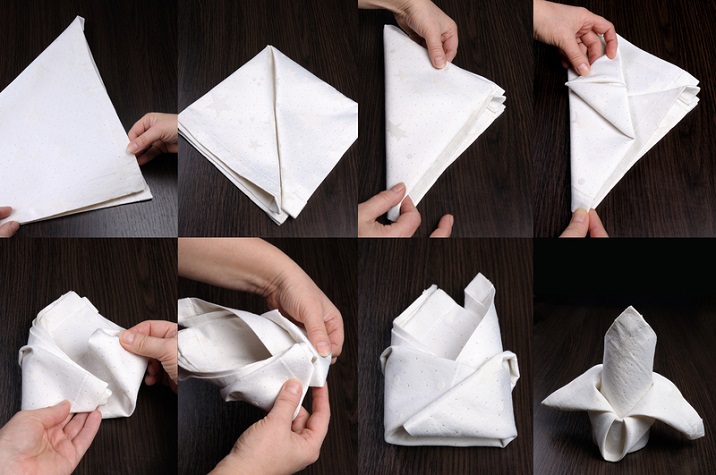
Food Presentation
Presentation of a food or beverage is equally important as its recipe as the other senses are stimulated through sight and aroma. A well-prepared dish is complete only when it is presented with beautiful garnish in an appropriate food container or platter. The serving staff must follow the basic guidelines for food presentation −
- It must be presented at the required temperature.
- It must be presented according to the serving size.
- It must be presented in appropriate hollowware of suitable size.
- It is also recommended to serve food with the right garnish that adds to the catchiness of the dish. The garnish in contrast color is quite appealing.
- The garnish or accompaniment should not overshadow the main food.
The cook needs to be creative at presenting the dish so well that the final result comes out as a treat for not only the taste buds but also for the eyes.
Beverage Presentation
Beverage presentation gains a lot of importance in today’s world. Beverages taste good if they are presented at the temperature at which they are meant to have. Right from selecting the appropriate service glassware, creating various pleasant color schemes of the ingredients, and serving the beverage with creative ideas pays.
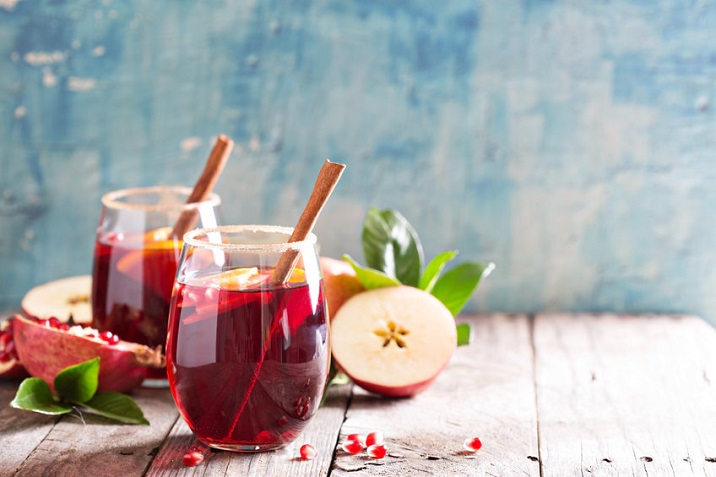
For example, the coconut water from a tender coconut can be served in the neatly cut and clean tender coconut itself from which it is taken out. Also, mocktails or cocktails can be presented with straws and slices of fruits in different shapes and colors.
Food and Beverage Services - SOPs
When the tasks in an organization are repetitive, it is required to generate a set of Standard Operating Procedures (SOPs). These make the tasks in hand easier and effective, and save a great deal of time and efforts. The SOPs also help to avoid common errors.
Let us understand a few important SOPs set in F&B establishments −
SOP for Laying Out a Guest Table
The procedure is as follows −
- Check the linen. Replace if required.
- Confirm the type of dining (Formal/Informal).
Table Layout for Formal Dining
For a formal table setup, place the tableware as follows −
- Service plate (dinner plate) one inch inside from the table edge.
- Salad plate on the top of the dinner plate.
- Forks on the left according to their size with the biggest fork being nearest to the dinner plate.
- Dinner spoon and knife on the right side of the dinner plate.
- Dessert spoon and fork on the top side of the plate horizontally.
- Bread plate (quarter plate) on the top-left corner of the dinner plate and a bread knife on top of it with its cutting edge pointing outwards.
- Water glass and wine glass on the top-right corner of the dinner plate.
- Neatly folded linen napkin on the extreme left just after the salad fork.
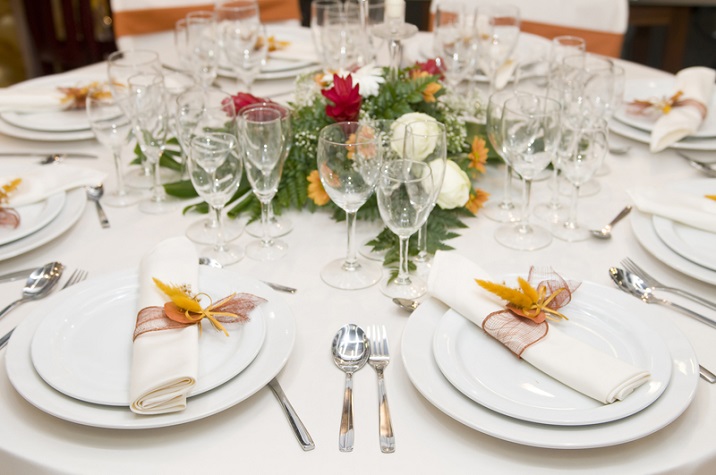
Table Layout for Informal Dining
For an informal table setup place the tableware as follows −
- Dinner plate one inch inside from the table edge.
- Forks on the left side according to their size with the biggest fork being nearest to the dinner plate.
- Dinner spoon and knife on the right side of the dinner plate.
- Water glass and wine glass on the top-right side of the dinner plate.
- Neatly folded linen napkin on the top of the dinner plate.
SOP for Handling Telephone Calls
The staff members who handle the telephone calls must be thoroughly aware of the work system. The procedure for handling calls is as follows −
- Always attend the phone call instantly, preferably within three rings.
- Speak attentively with the caller. Avoid speaking with anyone else present around when the call is going on.
- Always inform the customer if the call needs to be transferred or if the customer needs to be put on hold.
- Always address men customers as “Sir” and women customers as “Madam”.
- Do not keep any doubts unresolved before finishing the conversation.
- Speak politely and clearly; not loudly.
- Avoid jargons and informal words such as “Yup”, “Huh-Huh”, or “ok.” Instead, use words such as “absolutely”, “certainly”, and other similar words.
- Always end the call saying, “Thank you for calling”.
SOP for Taking Orders
The orders for table reservation or food delivery can be taken on phone. Direct service orders are placed and taken at the guest table.
Taking Orders on Phone
The visual channel of communication is not available while taking orders on phone. So, the staff needs to pay complete attention to what the caller says while taking order on the phone.
- Answer the customer’s call immediately by saying, “Good (morning/afternoon/evening), I am (own name); How can I help you?”
- Listen attentively to the customer’s requirement of food, beverage, or table reservation.
- Note down order details on a notepad.
- Tell the customer about estimated time of delivery if it is home delivery service. If it is table reservation, confirm the timing, number of persons, and preferably the occasion.
- Repeat the order to the customer and take confirmation.
- Ask for the address or confirm the address and contact number if it is already in the database.
- Terminate the conversation by greeting the customer.
- Inform the kitchen staff and delivery staff member in case of home delivery. Inform the service staff to prepare a table for the given number of persons and the occasion in case of table reservation.
Taking Orders at the Table
This happens when the guests are already seated.
- Make sure the guests are seated comfortably.
- Show them welcome drink or chilled water.
- Greet the guests and ask them, “What would you like to have, (Sir/Madam)?”
- Note down the order carefully.
- Ask about which variant of the food or beverage they wish to have; if there are any for the same food item. Suggest the beverage or side dish that goes well with the main dish if required.
- Repeat the order to the guest with their respective quantities.
- Inform the guest about expected time of order arrival.
- Leave the guest table to transmit order to the kitchen.
SOP for Conversing with a Guest
Conversation with the guests is the backbone of any service-providing business. The guidelines for conversing with the guests are −
- Keep upright posture and smile on the face while speaking to the guests.
- Let them know, as a service staff, you are eager to serve them.
- Be respectful to elderly guests, friendly with the same-age guests, and jovial with the children.
- Keep the voice of speech audible while talking.
- Apologize if some food item or beverage has run out of the stock.
- While the guests are having their meals, make a round to observe if everything is fine at the table.
SOP for Dealing with Unforeseen Circumstances
The service staff actually must remain prepared to handle any unforeseen circumstances which include −
- Handling spillages while serving.
- Dealing with the highly drunk gusts.
- Dealing with the guests with zero or partial eyesight or any other physical difficulty such as a fractured leg.
- Dealing with the guests who show difficulty in communicating.
- Dealing with active toddler guests.
Carrying and Loading the Trays
The service staff needs to be careful while carrying the trays in their hands and going around the dining area. They need to follow a decorum while carrying and loading the trays.
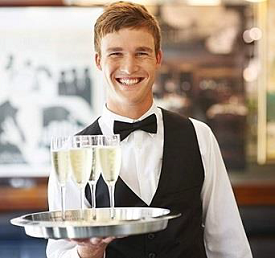
Carrying the Trays
- Carry one tray at a time.
- Carry it on the left hand slightly above the shoulder.
- Hold it little away from the neck and mouth for the hygienic reasons.
Loading the Trays
- Do not overload the tray to avoid spilling.
- Keep the tray load always evenly distributed.
- Adjust the position of drinks or food briefly every time something is removed from it.
Serving Food and Beverage
The following are some meticulous ways while serving food or beverage.
- Bring the food to the guest table unless it is buffet service.
- Always present the food from the guest’s left side in case of formal dining.
- Prepare the food plates from the kitchen and place them on the guest table in case of casual dining. The guests then serve themselves.
- Serve one food item at a time.
- Serve the eldest lady guest of the group first unless the lady herself is a host. After all ladies are served, serve the men guests starting from the oldest.
- Always present a dish with its respective serving spoon.
- Lift the service platter up and take away after serving.
- Always present a drink in an appropriate glass with a straw. Plain straw is light so keep it out of the glass while serving. Designer straws are placed into the glass while serving.
- When same wine is offered in consecutive courses, serve it in the same wine glass. Else replace soiled glass with the fresh one.
- Always follow the right way of pouring aerated drinks or fuzzy drinks by tilting the glass and the bottles so that the drink head and aroma remains held.
- Do not bend over served plates while serving other plates across the table. Move as nearest as possible to the plate.
Clearing Tables
It is important to clear the table between two dining sessions by the following this procedure −
- Clear the table first time when the guests finish main course. Clear it for the second time just before the guests leave the table.
- While clearing, remove used and unused pieces of flatware and chinaware except table linen and center piece. Let the dessert flatware remain if it is first clearing.
- Let the wine glasses remain even after the main course. When same wine is offered in consecutive courses, serve it in the same wine glass. Else replace soiled glass with the fresh one.
- While clearing, pickup one plate and place on the tray at a time. If it is a formal dining, slide a fresh plate in place of the removed plate so that the table cover of the guest is never empty.
- Do not overload the tray with pile of used plates. Make extra rounds to the table if needed.
Presenting and Settling Guest Bills
Before presenting the bill to the guest, make sure the guests don’t want to order anything more. There are many policies of setting guest bills in the F&B establishments. Some prefer the guests pay cash at the cash collection counter. In such case, the serving staff must accompany the guest to the payment counter to ensure only the right amount is charged to the guest.
Some F&B Services businesses prefer to bring bills (checks) to the guests’ tables and get them settled. While presenting and settling the bill, follow the given steps
- Ask politely, “Should I bring you the bill, Sir?”
- Once the guest confirms, ask for the mode of payment. It should be either credit card, debit card, or cash.
- Go to the payment counter to prepare the bill.
- Cashier prepares the bill according to the table number told by the waiter.
- Present the bill in a small closed folder to the guest from left side.
- Stand beside the guest patiently till the guest examines the bill.
- If the guest pays by cash, take it and deposit the amount at the payment counter. If the guest wishes to pay by card, take the guest’s signature on the bill, and take the card and bill to the payment counter. If the establishment has facility of mobile payment service, take the device to the customer.
- The cashier returns the balance amount if paid by cash. If the payment is by card, the cashier checks the expiry date on the card and accepts the payment.
- Bring back any change or card, and the copy of printed bill to the guest.
- If the guest insists to take the tip, mention thankfulness with smile.
- When the guest stands up to leave, pull the chair backwards to help him get out of the chair gracefully.
- Thank the guest for the visit and invite to visit again.
F & B Services - Hygiene & Safety
It is an extremely important responsibility of every F&B Services to serve their guests hygienic food and beverages. The guests keep faith in F&B Services businesses that they will provide them the best food and serve it the best careful manner. The F&B services are bound to provide safe-to-eat food that is prepared by following hygiene and sanitation practices.
Importance of Hygiene in F&B Service
F&B services have direct access to guests’ health through food and beverages. The working staff handles every food and drink item closely that the guest is going to eat. Hence, if these services do not follow proper practices of hygiene and sanitation, the guests might get foodborne diseases such as food poisoning, nausea, diarrhea, or vomiting.
Food contamination can occur through unwashed vegetables, uncooked meat, soft cheeses, and unpasteurized milk. If the food preparation and serving equipment used in F&B Services are not clean, then they become primary source of food contamination.
Types of Food Contaminations
There are three main sources of food contamination −
- Physical − This is accidental in nature and is caused by employee carelessness. The major culprits are air, dust, smoke, and dirt. To prevent this, food must be properly covered and stored.
- Biological − This contamination is caused by pathogens and microorganisms such as bacteria, molds, parasites, and fungi.

- Chemical − It is accidental contamination of food caused by cleaning solvents, pest control sprays, or other chemicals used in entire food production chain. This food contamination occurs when utensils or other tableware are not wiped dry after washing them using cleaning liquids. It also takes place when the food is not stored properly when pest control chemicals are sprayed.
Hygiene Concerns of F&B Services Staff
Personal hygiene is essential when one handles the food or beverage that the other is going to consume. The service staff must follow the given basic principles −
- It is said that the hygiene starts from home. Perform your daily cleanliness regime without any excuses.
- Wash hands and arms immediately −
- When you come from toilet.
- When you sneeze, blow nose, yawn, or cough covering your mouth with hands.
- After eating food, tobacco, or touching animals.
- After you touch hair, scalp, skin, or any body-opening.
- Wash hands with mild cleansing soap and warm water; not merely with running water.
- Wipe sweat often.
- Do not smoke or eat tobacco while working.
- Cover cuts, burns, or wounds on the skin.
- Keep hair and nails trimmed.
- Try using hand gloves as much as possible. Kitchen staff must use toque.
- Do not work when facing cold, cough, or any other contagious diseases. Inform your superior staff if you are not well.
- Do not touch ready-to-eat food directly. Always use gloves, serving tongs deli papers, or forks to handle such food.
- Do whatever required to let not your skin, body fluids, or any clothes you are wearing to come into contact with food or food containers.
- Ensure a clean uniform.
- Do not wear loose jewelry. Avoid wrist jewelry.
Hygiene Concerns of F&B Services Business
Any food business must be concerned about −
- Training all food handling and service staff with a detailed knowledge of food and equipment hygiene and safety.
- Ensuring food handlers and servers not to handle food in case of contamination possibility.
- Supplying hand-washing facilities with soap, running hot water, and paper towels for its staff.
Food Safety Concerns
Every F&B Services business must also be concerned about food safety and adhere to safety of food and beverage it serves. It must ensure −
- Marking Date on Food − The perishable ready-to-eat food refrigerated for more than 24 hours must be clearly marked at the time of preparation to indicate the date by which the food should be consumed.
- Storing of Food − Hot and cold foods and beverages need to be stored at the right temperature. The food temperature measuring devices must be accurate.
- Cleaning Equipment − The area and facilities allocated for cleaning food preparation and service equipment must be large enough to immerse the utensils and sanitize them.
- Limiting Cross-Contamination − Storing raw food such as raw meat or vegetables from cooked food is essential to avoid cross-contamination of the food.
- Employing FSS − The F&B Services businesses must employee at least one Food Safety Supervisor depending upon the business size.
Safety of F&B Services Staff
Hygiene and safety of food starts right from selecting raw material carefully, preparing food with health and safety cautiousness, and serving it in the clean environment.
The service staff must −
- Attend duty in clean and tidy uniform.
- Wear less jewelry while working. This avoids entangling articles and calling for trouble.
- Be aware of the equipment and their appropriate application.
- Be careful of handling hot food and beverages.
- Clear spillages on the floor immediately.
- Never run in the workspace.

Our Portable Bar Services are a Perfect Fit for Home Parties, Corporate Events, and Themed Party, company product launches and conferences, birthday parties, weddings and more. We provide everything you could possibly need to make any event a great one!
ReplyDeleteGet your guests into a great party mood with mobar liquor catering services.
pop up bar singapore
Our portable bar services are perfect and very impreesive.
ReplyDeletefood and beverage design agency
Useful post, you have includes important subject matter in this blog. Best Wedding Planners in Bangalore
ReplyDeleteSuch a well-written post—these baraat welcome touches are exactly what make the first impression unforgettable. A Premium Beverage Stall for Baraat Swagat can be a real crowd-pleaser, and adding Crafted Personalized Coconuts for Baraat Swagat is a beautiful way to blend hospitality with personalization and photo-worthy details.
ReplyDelete